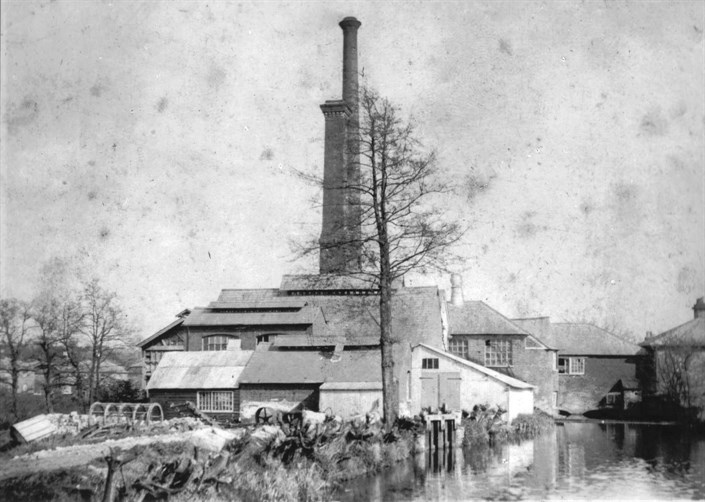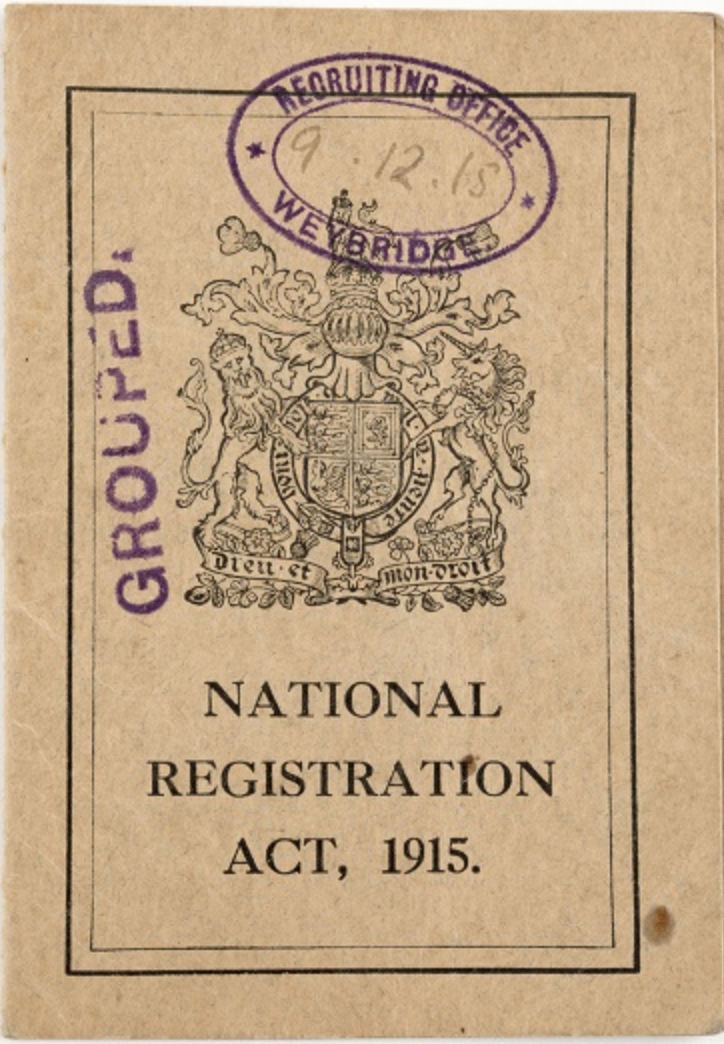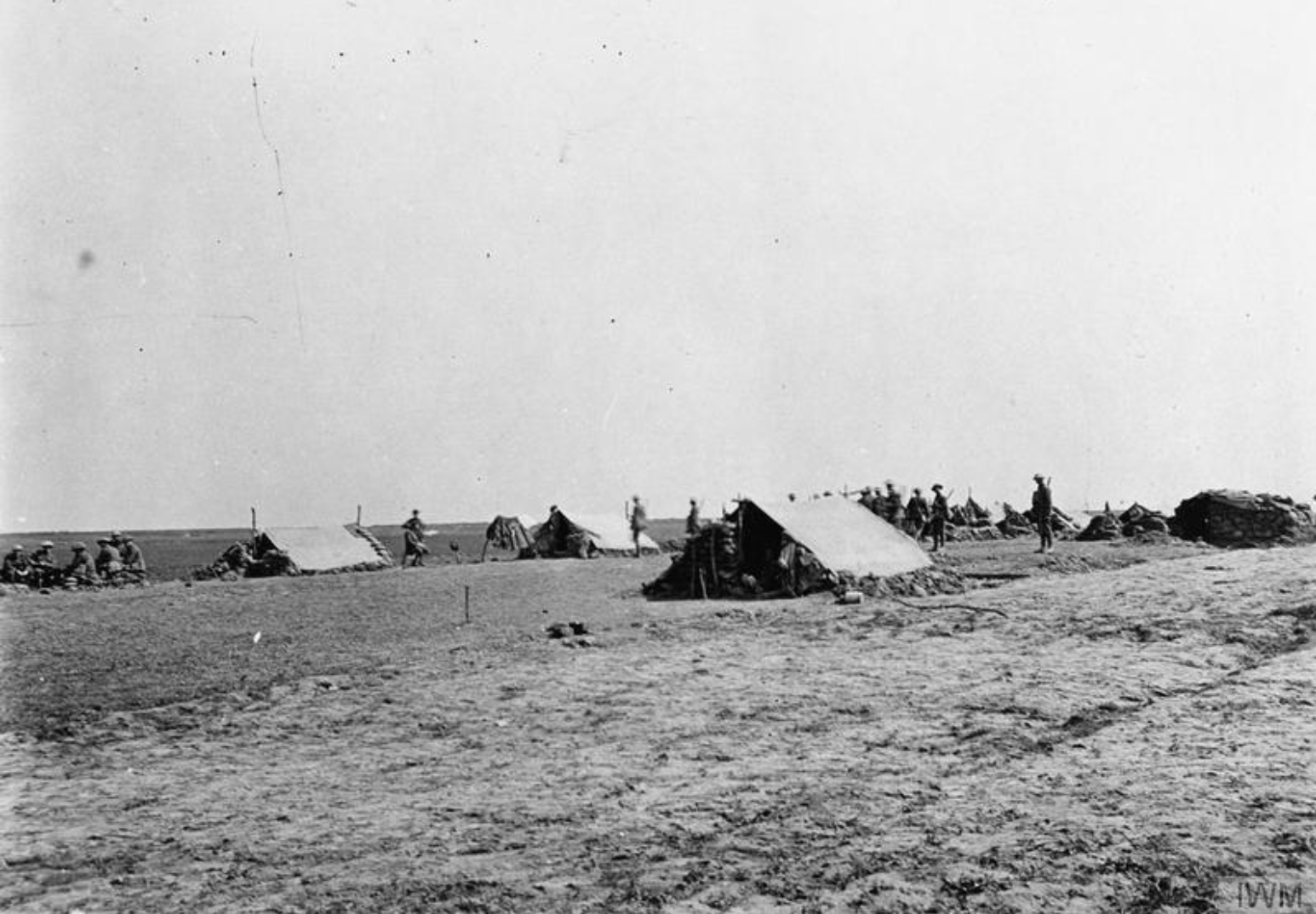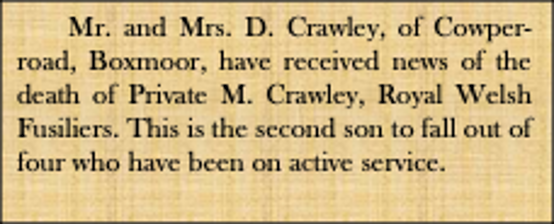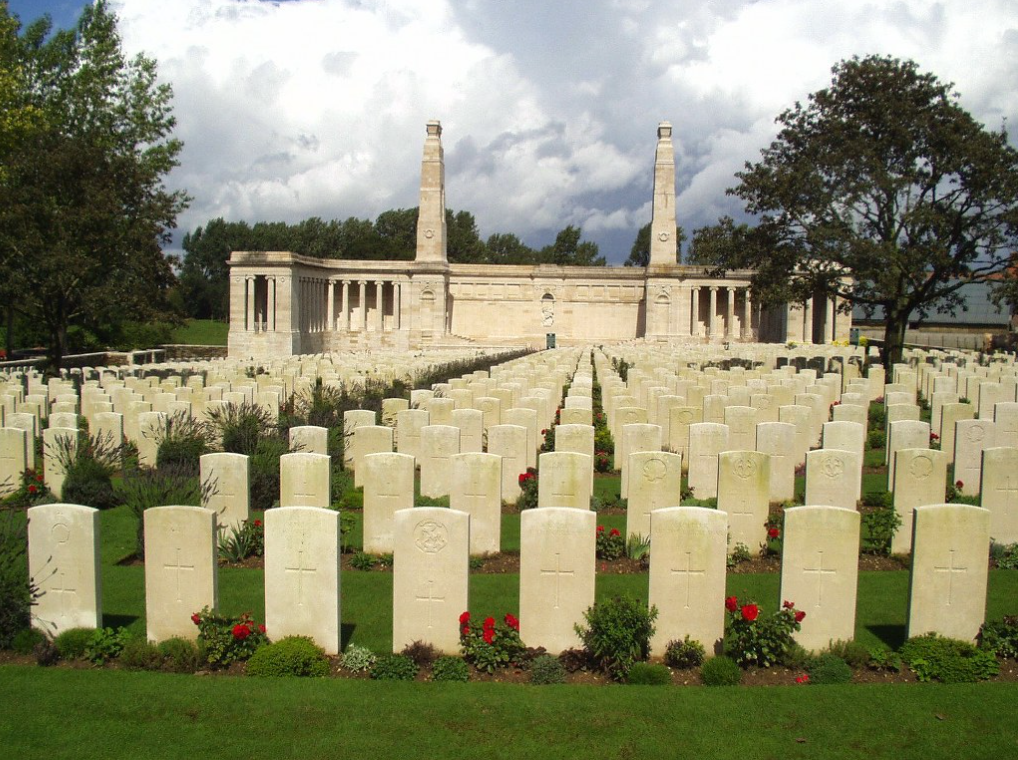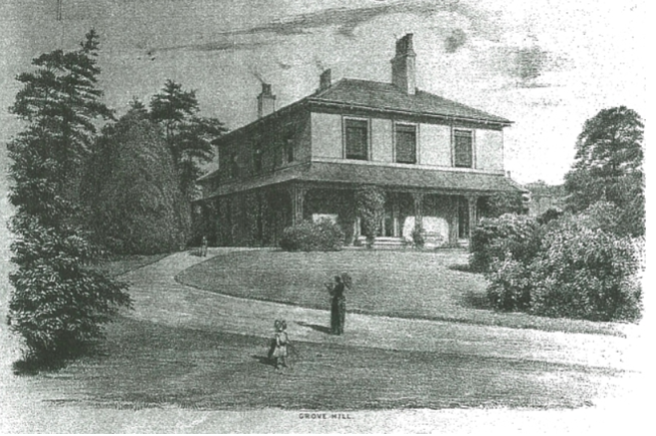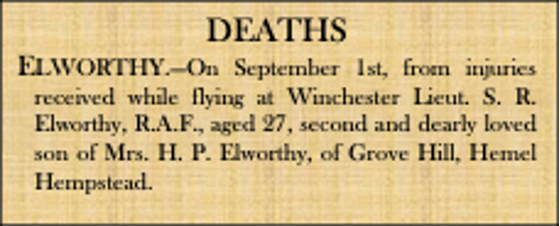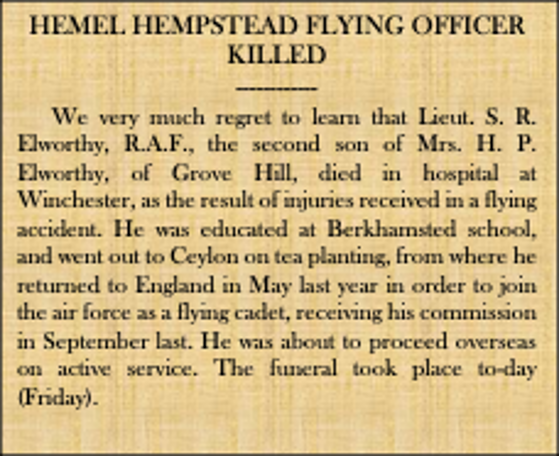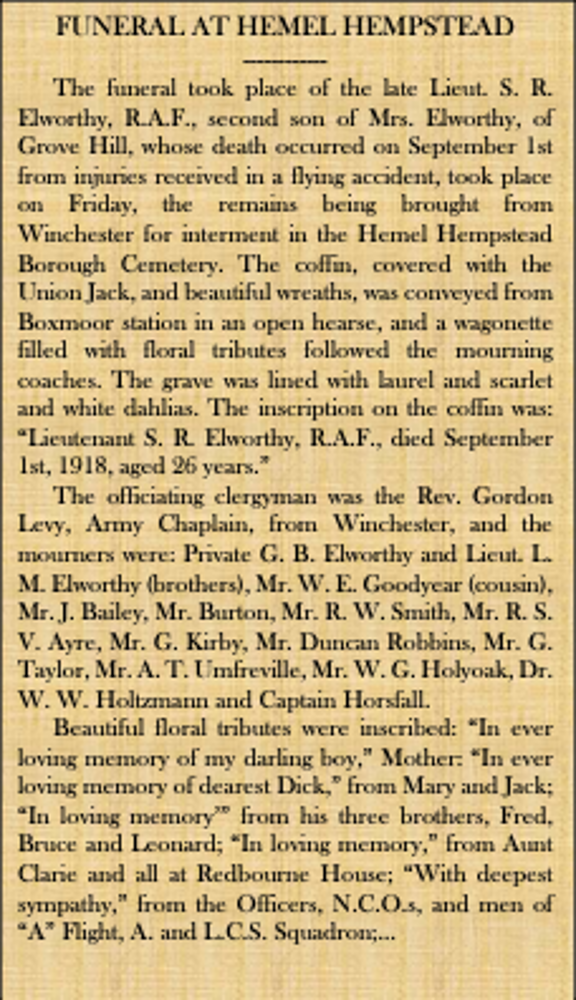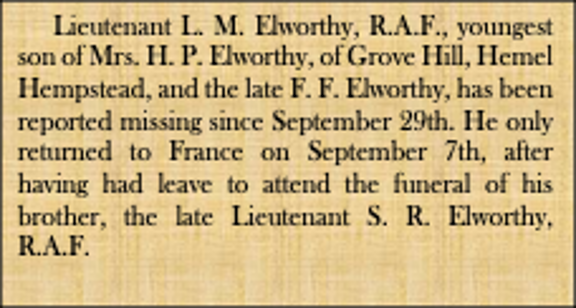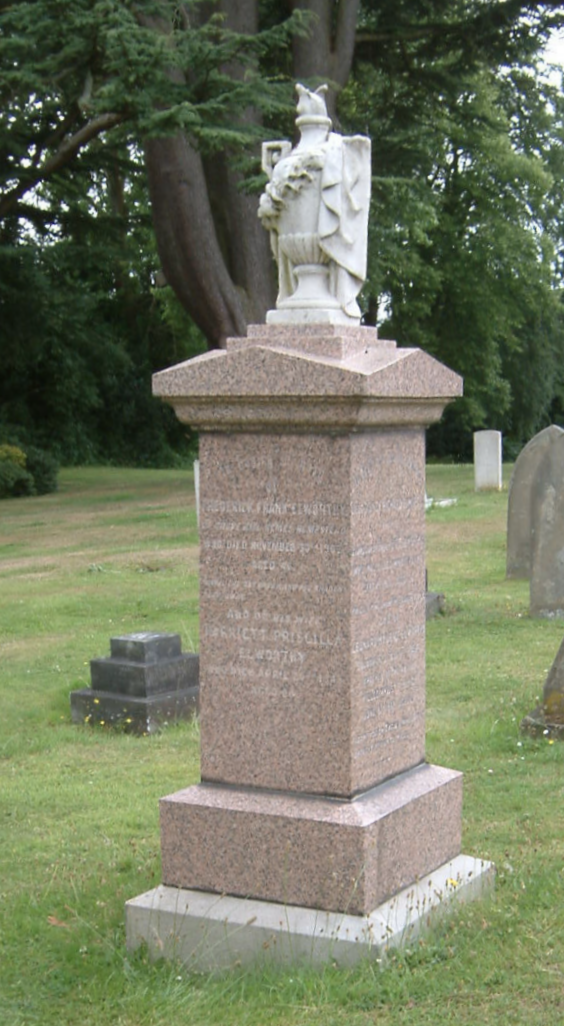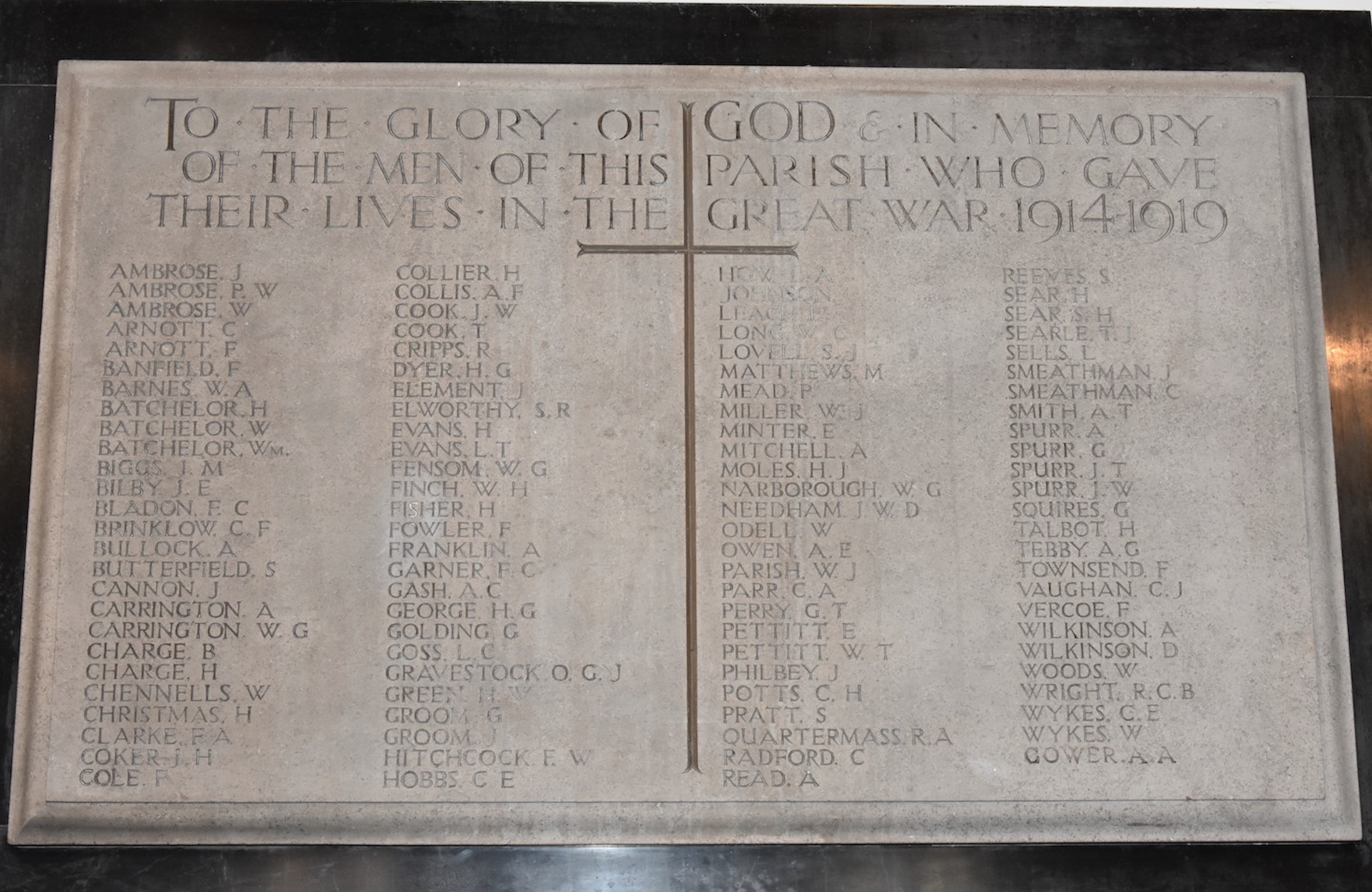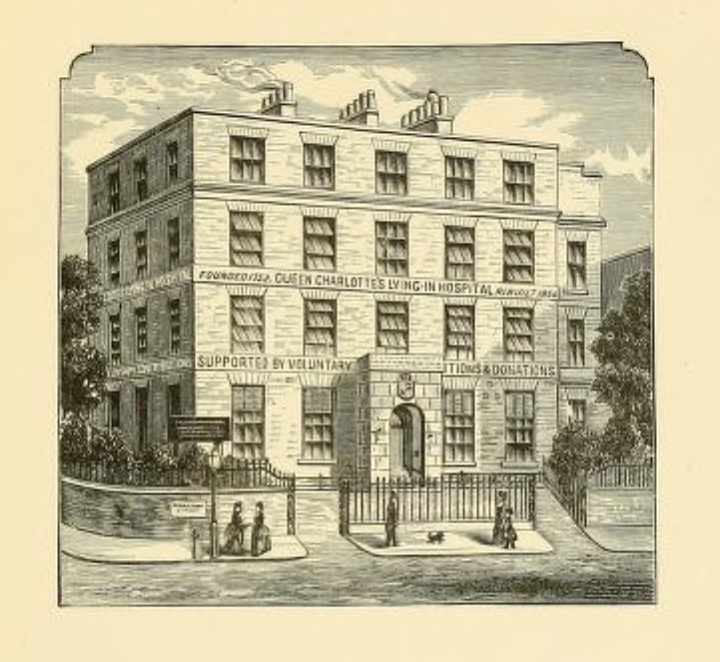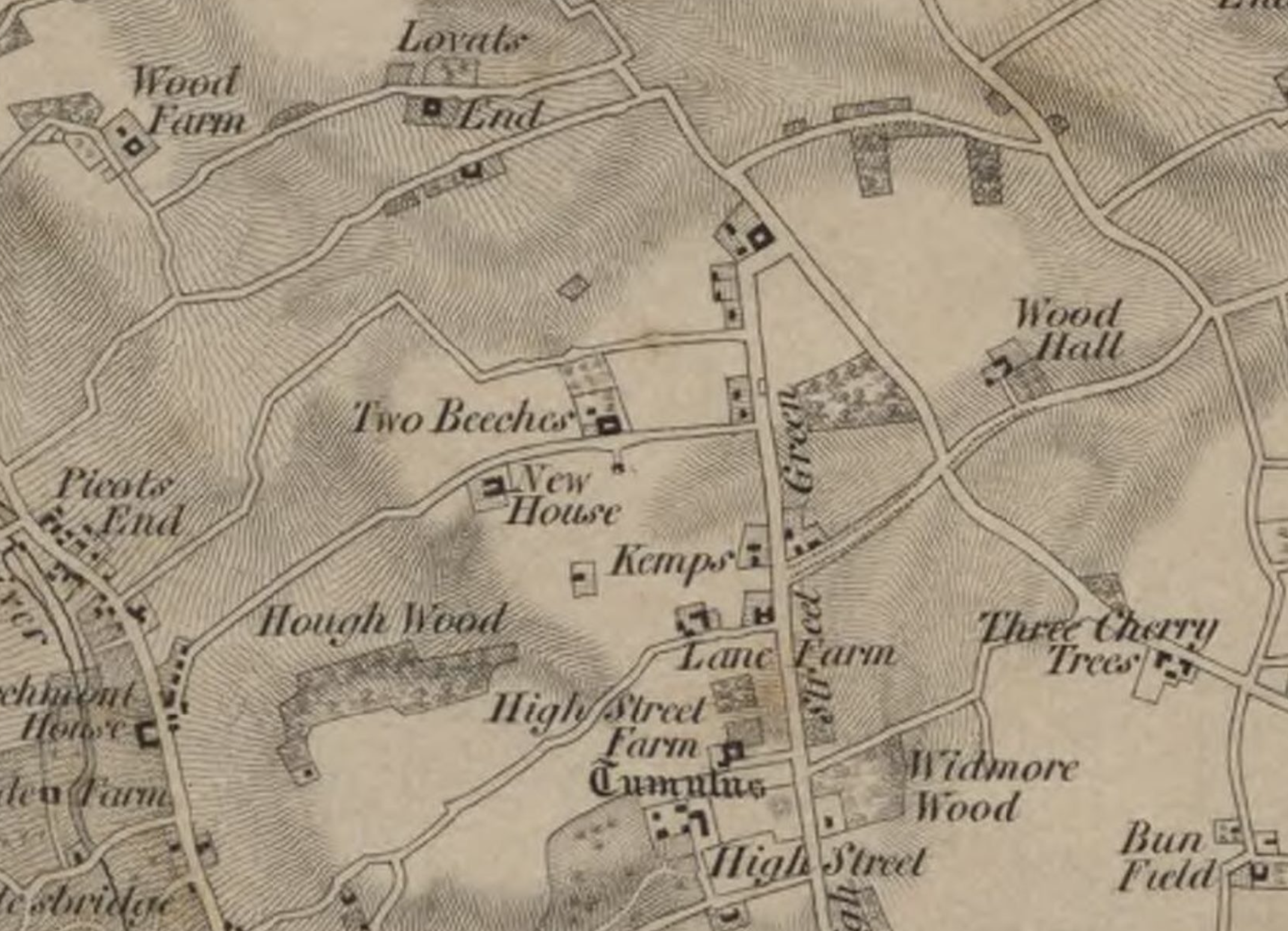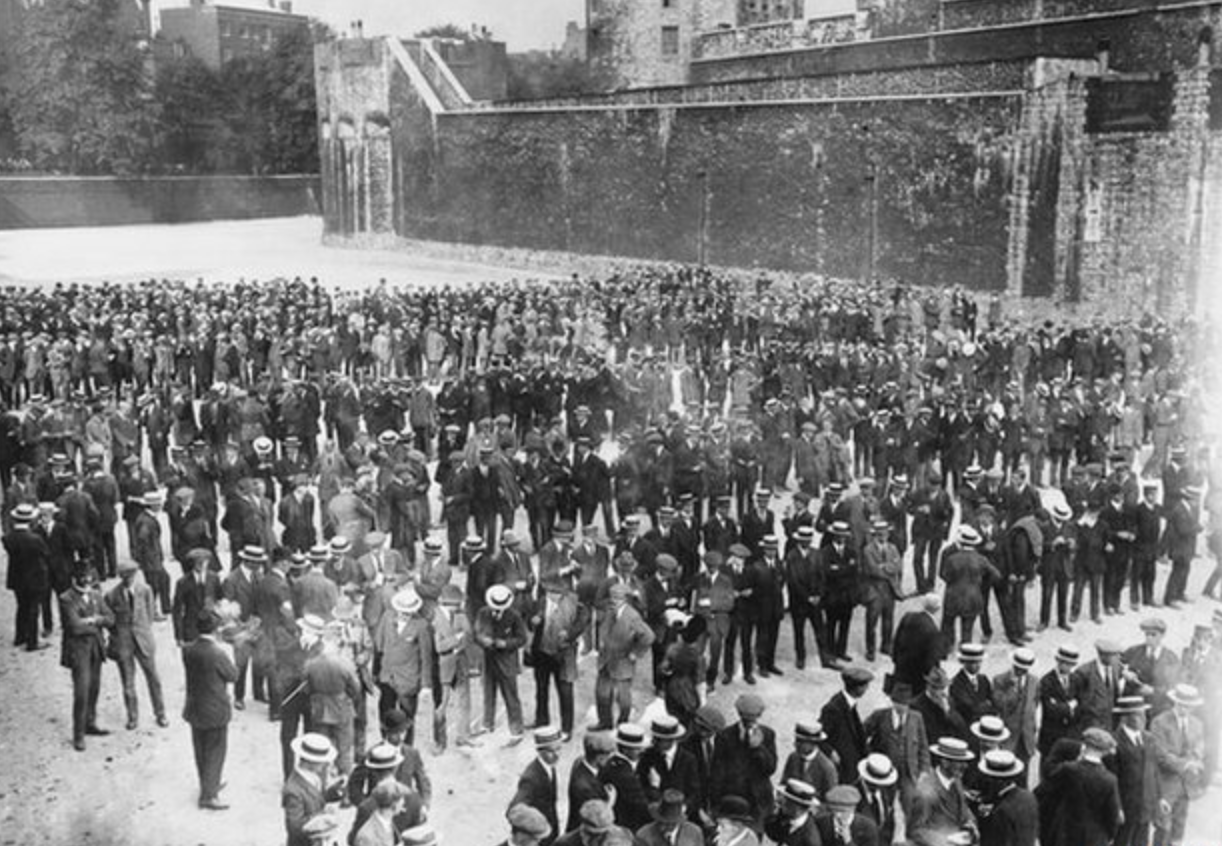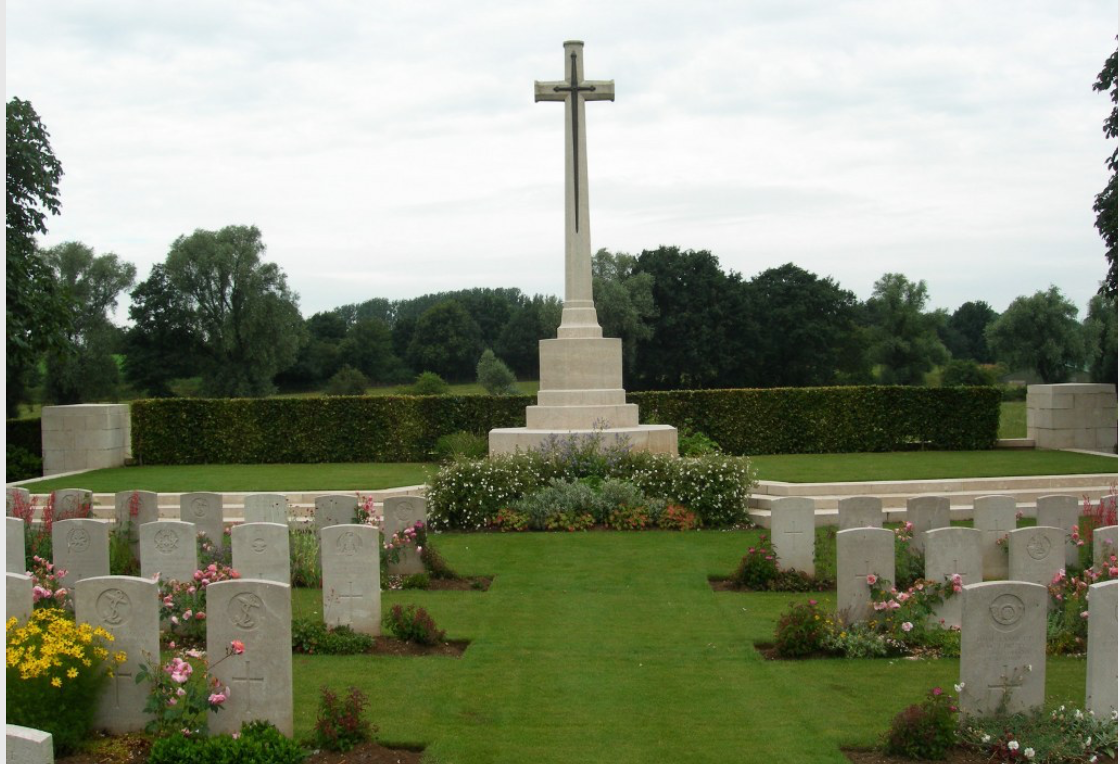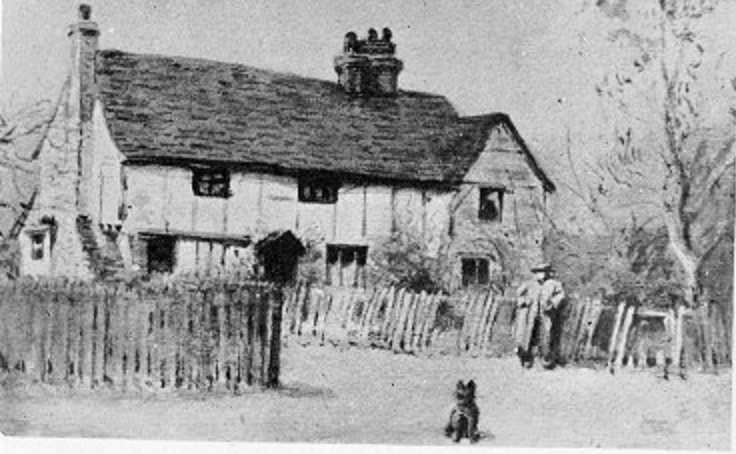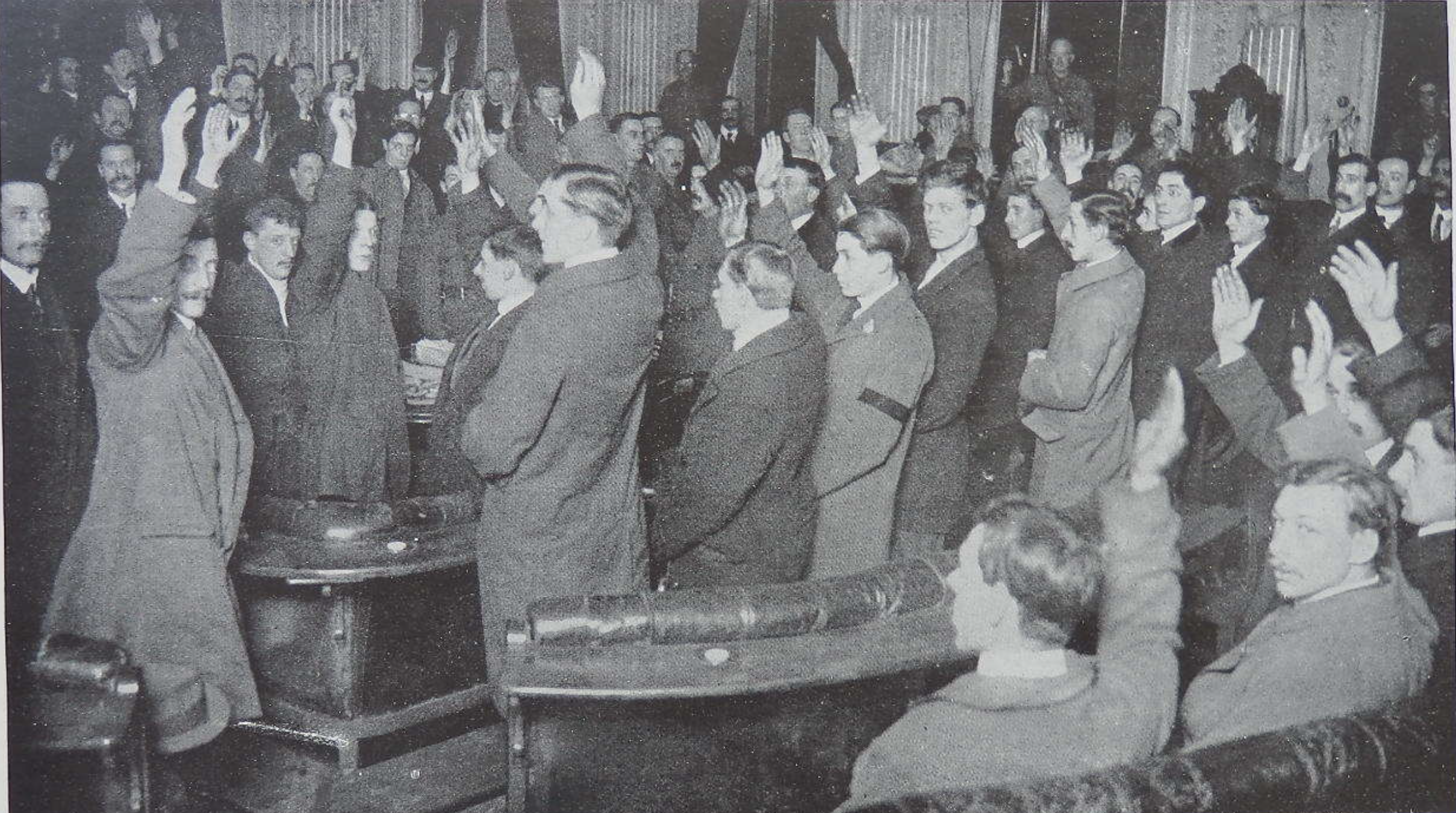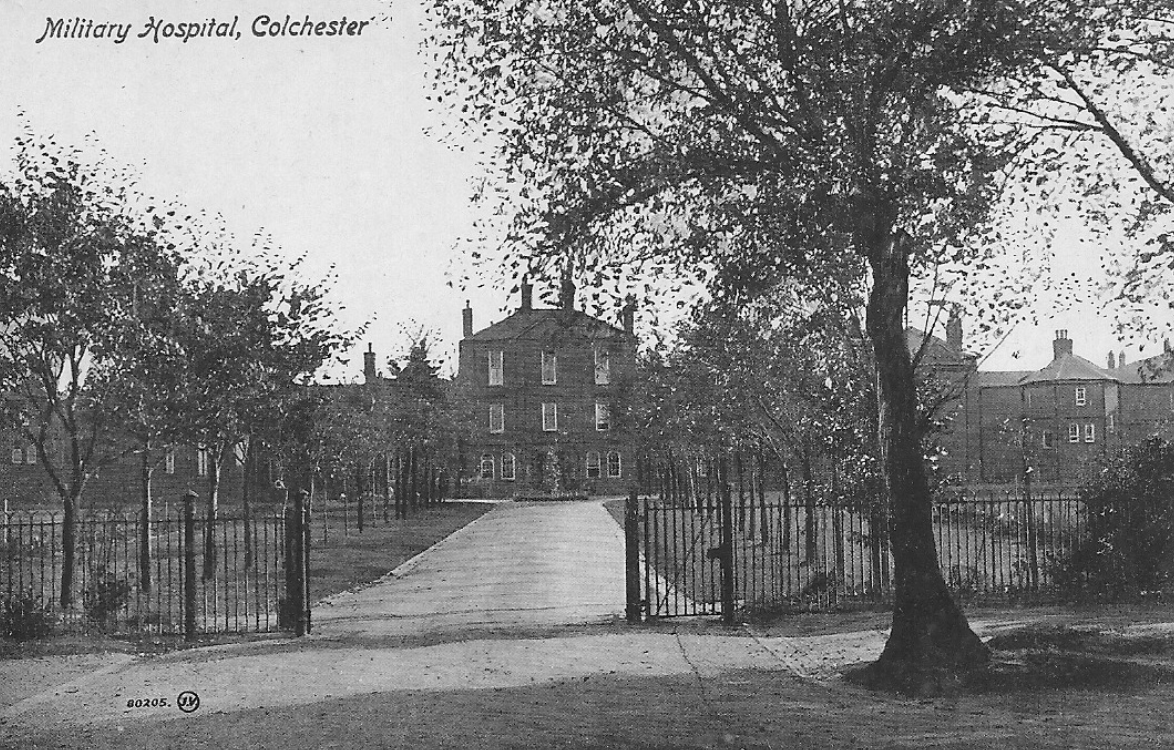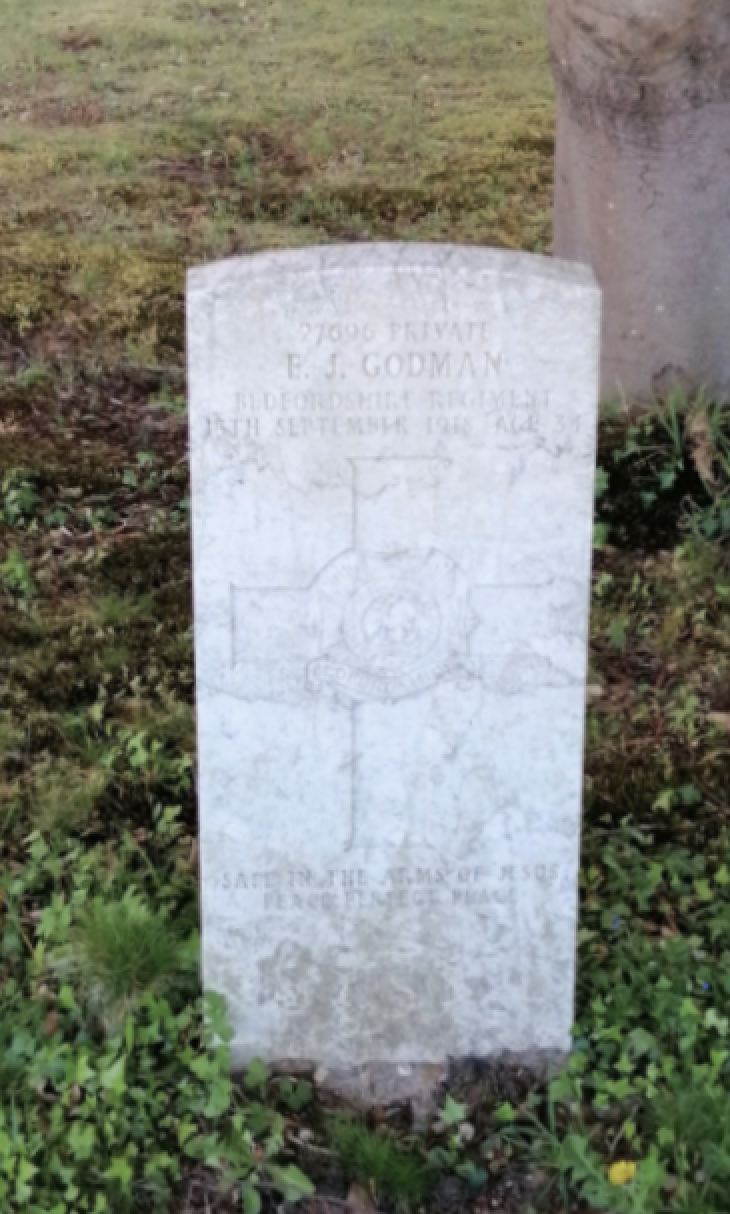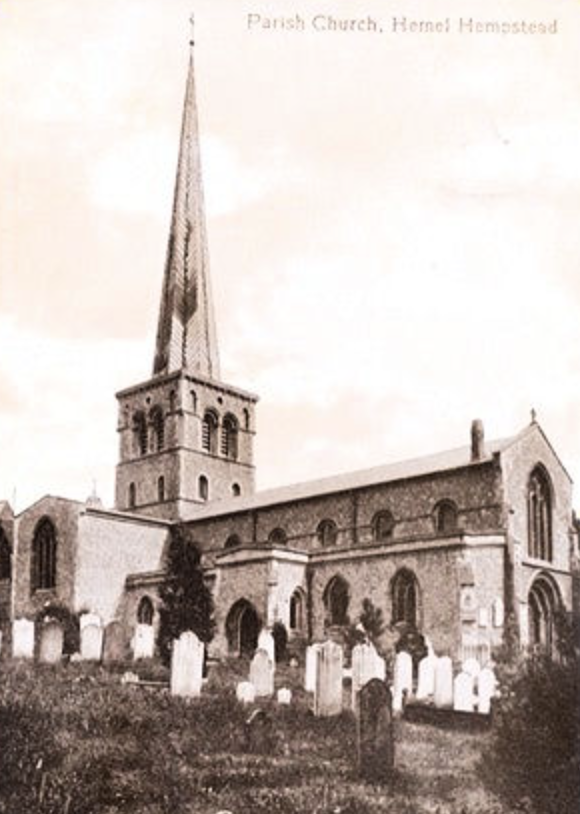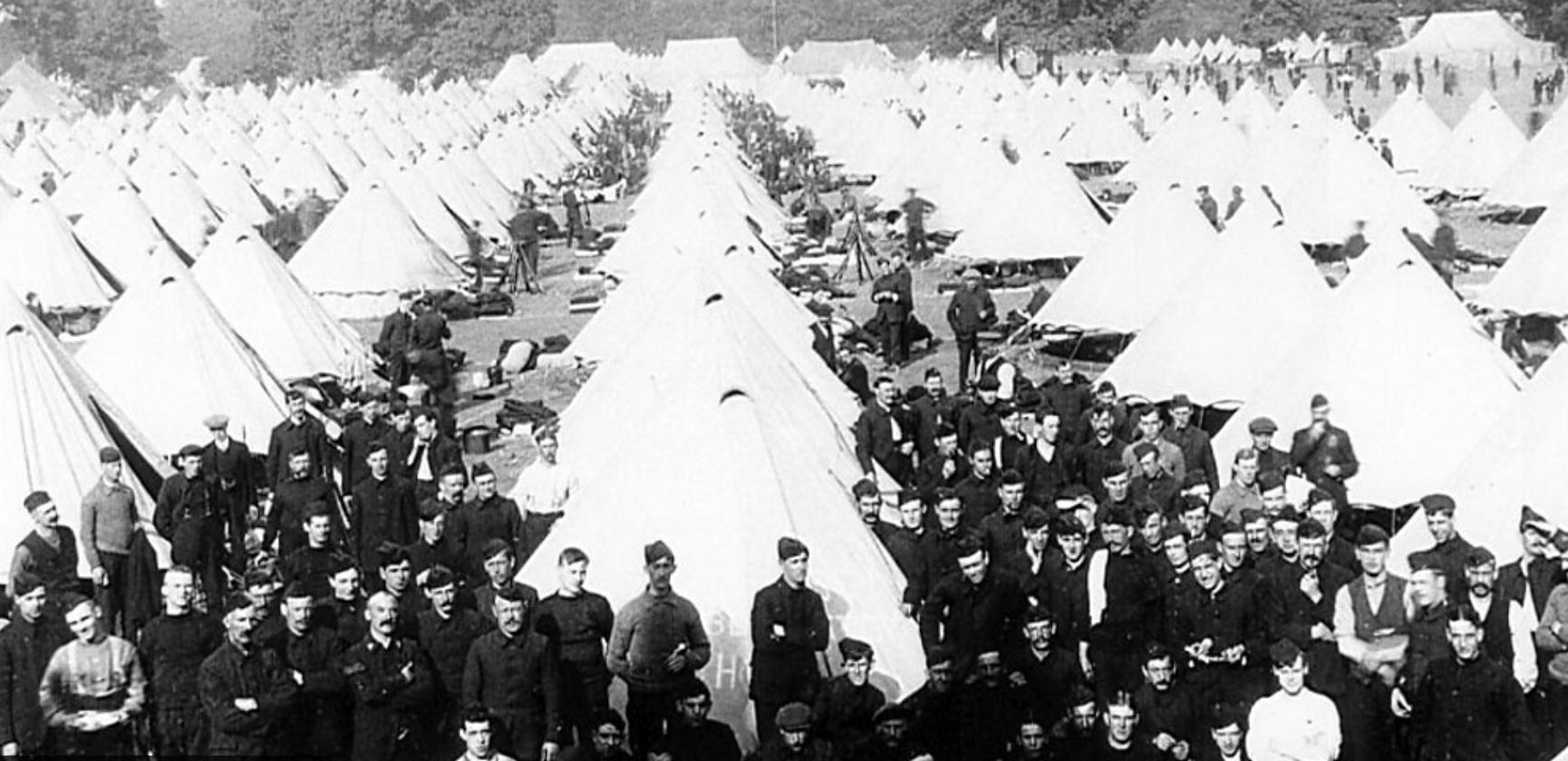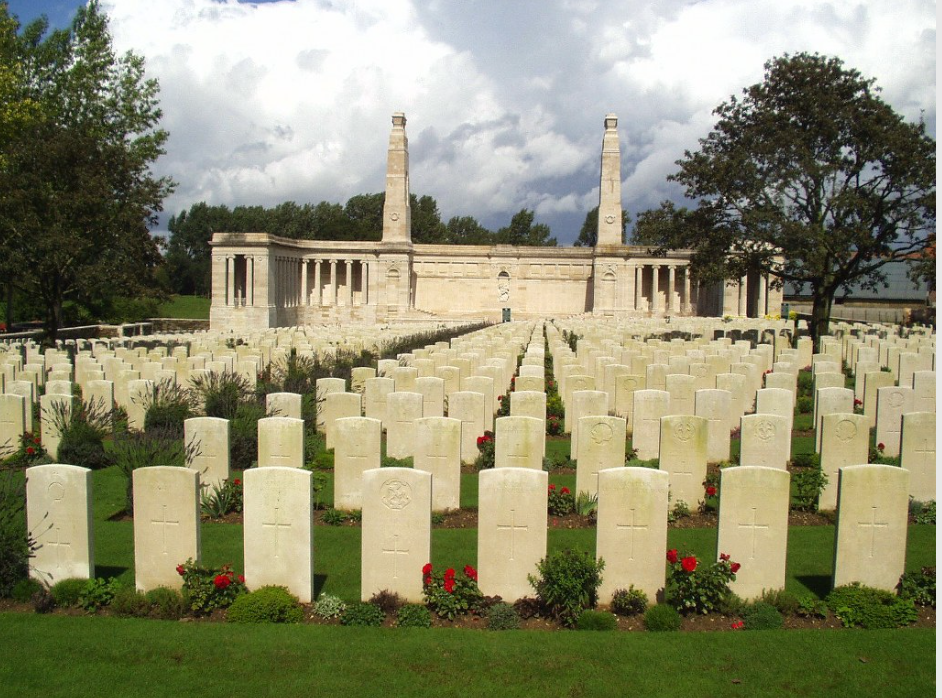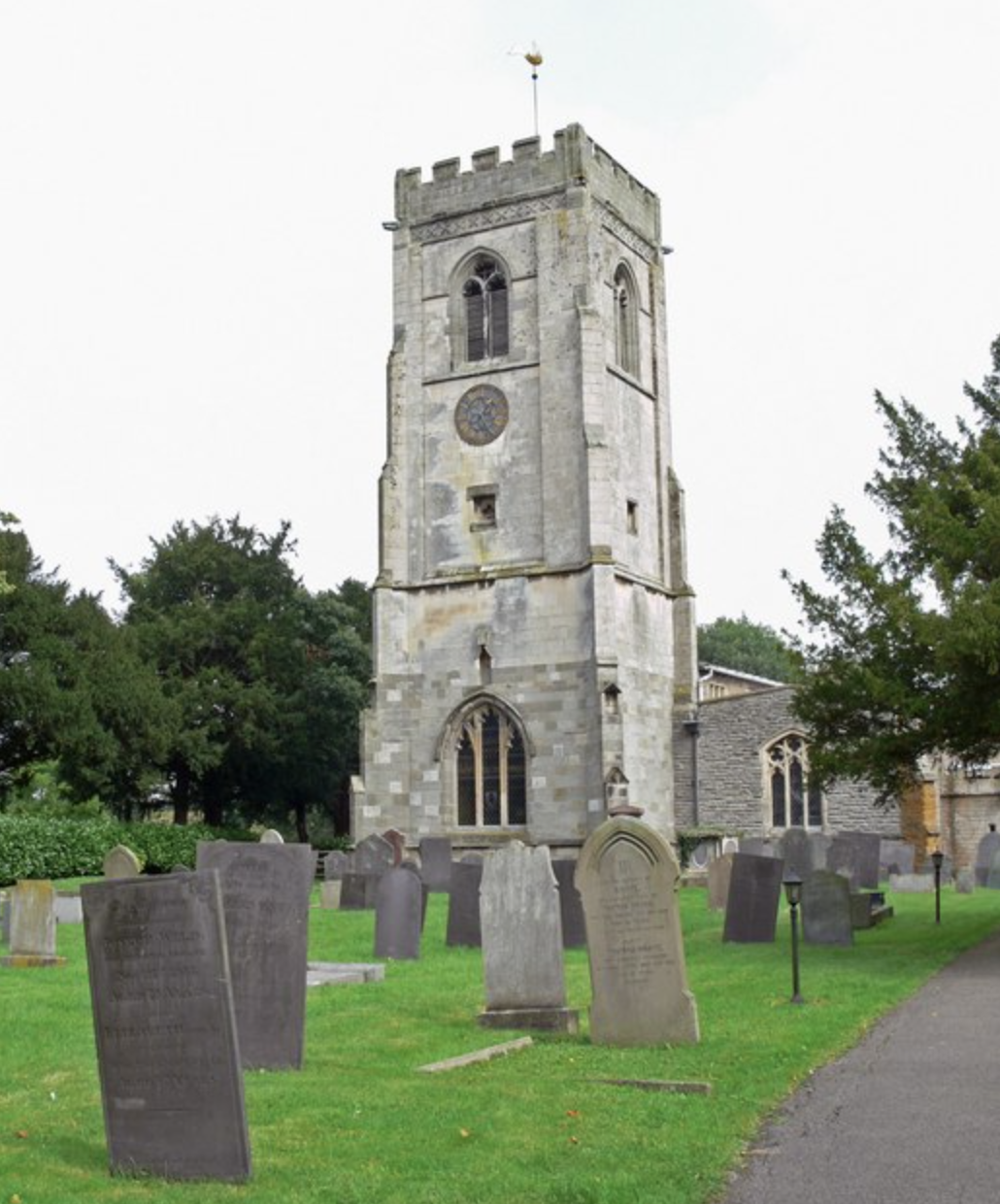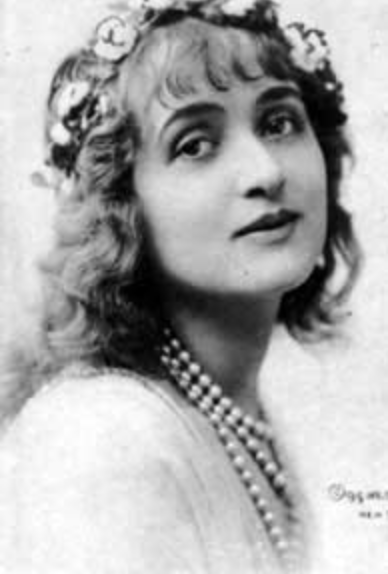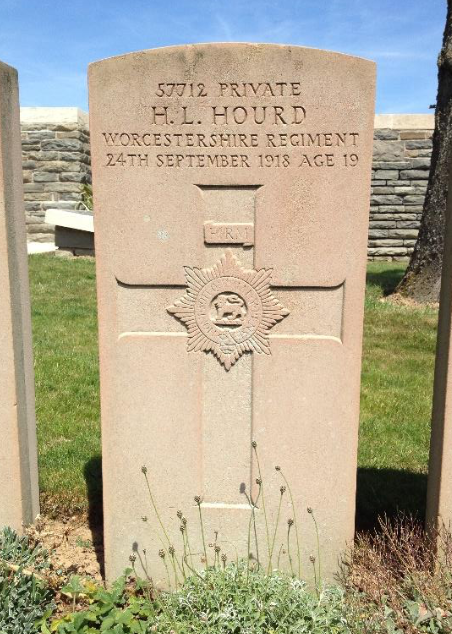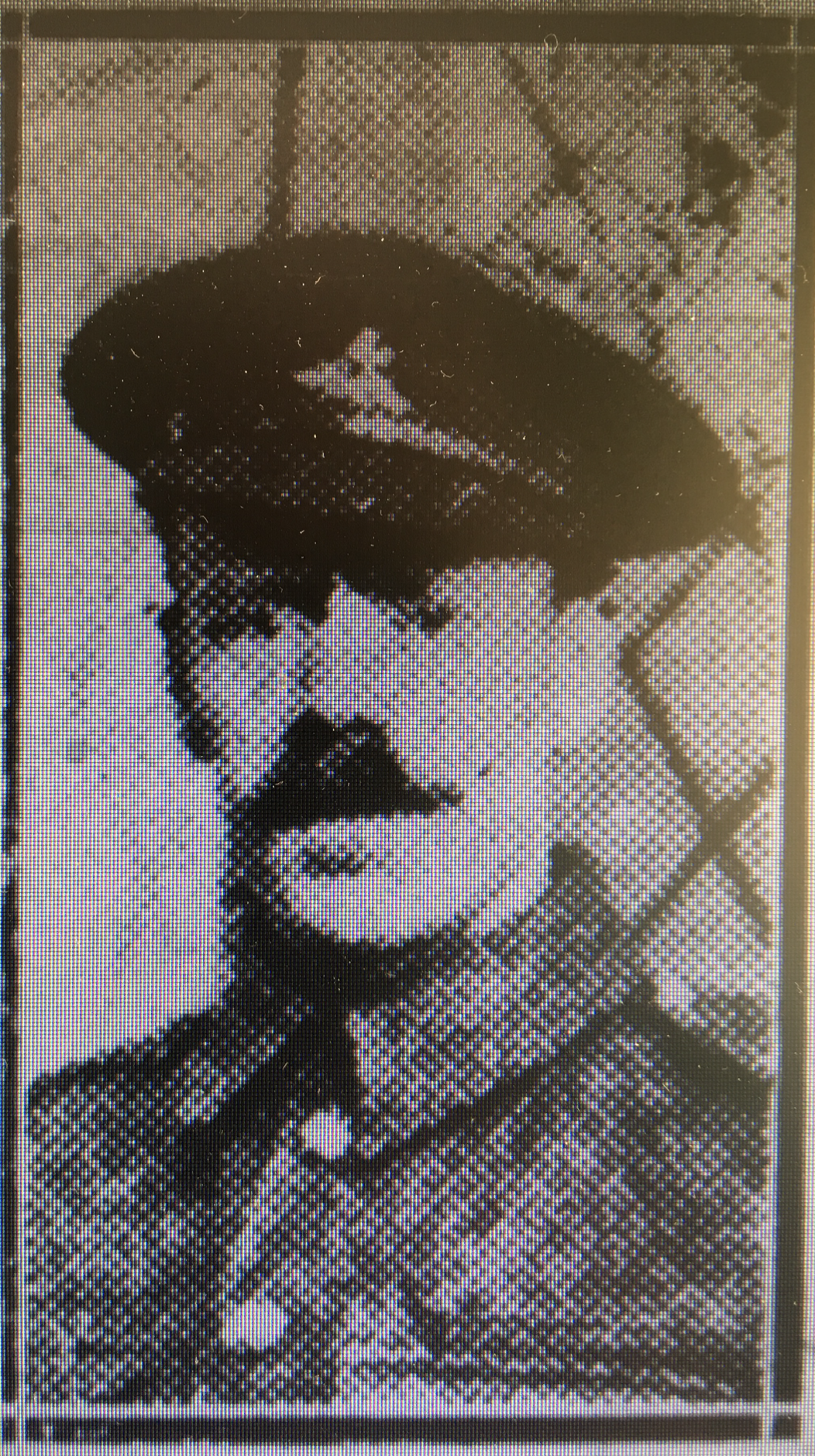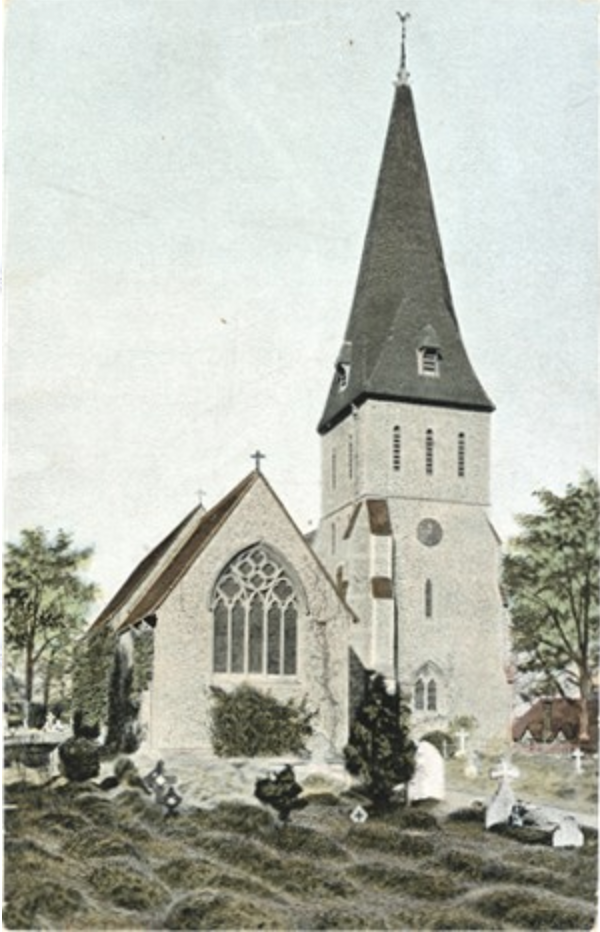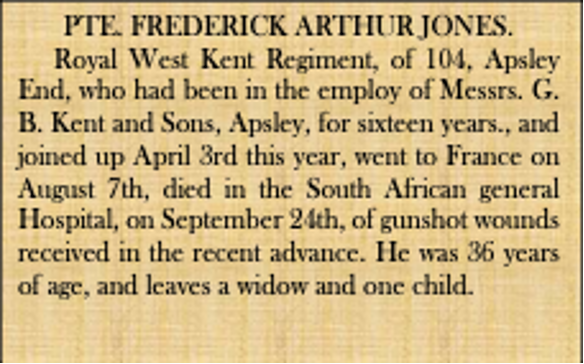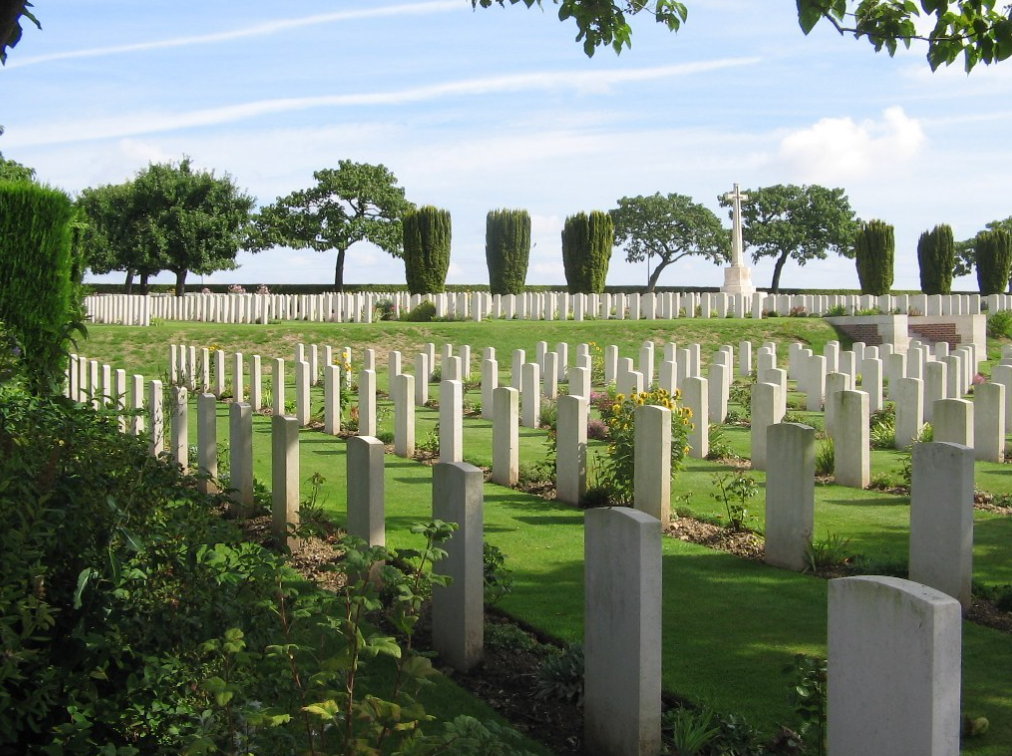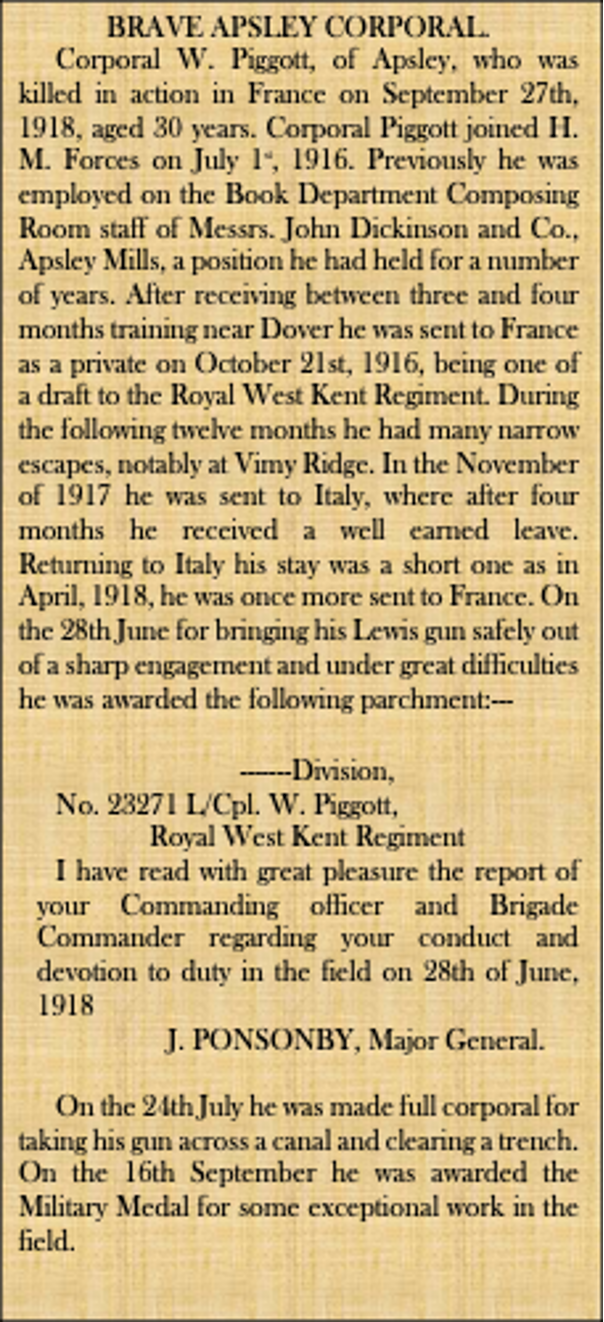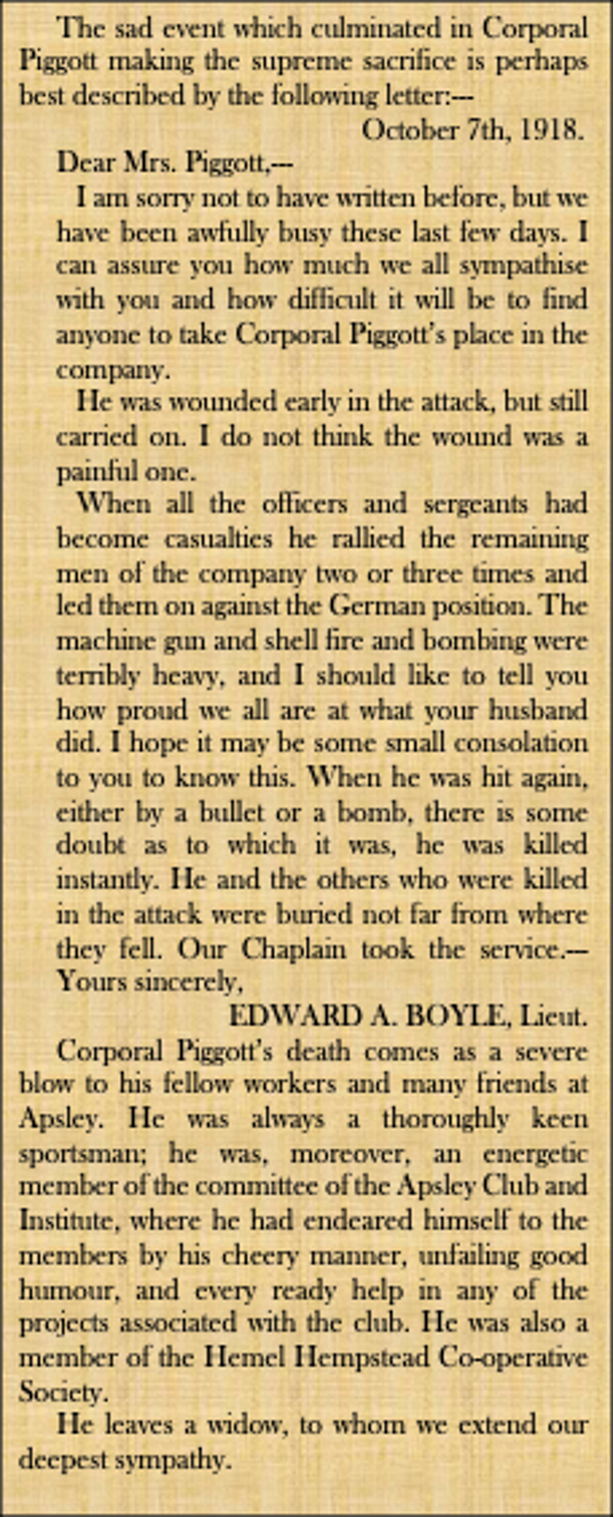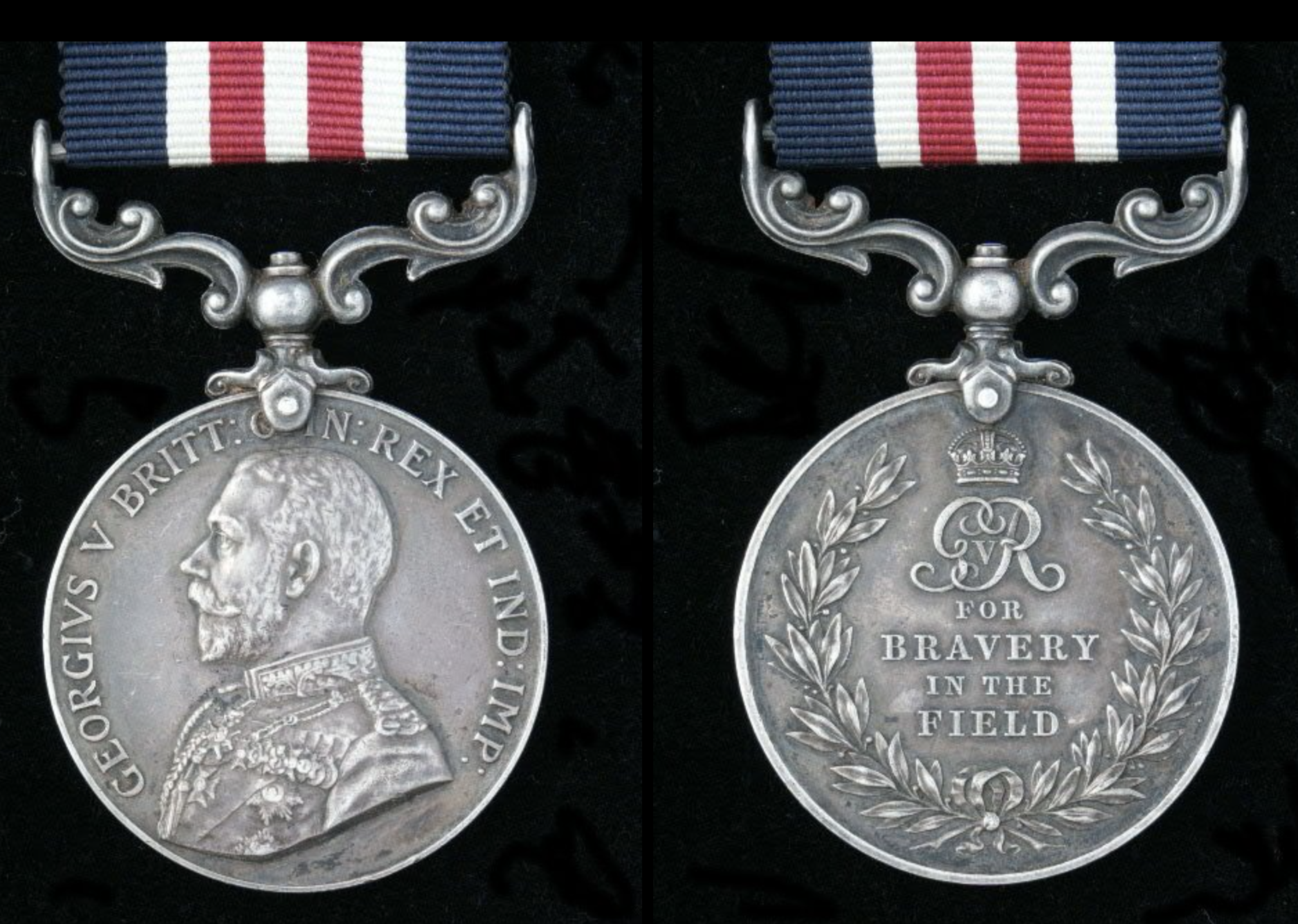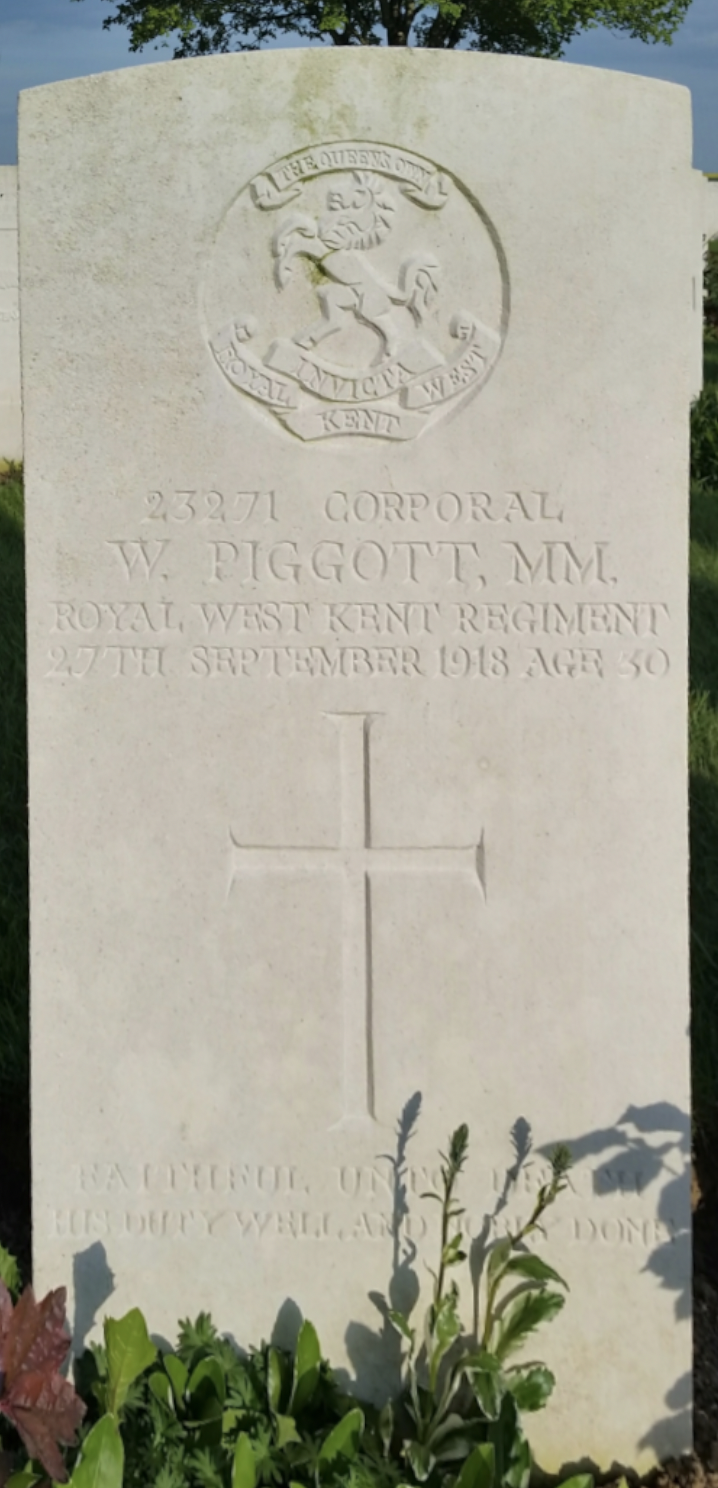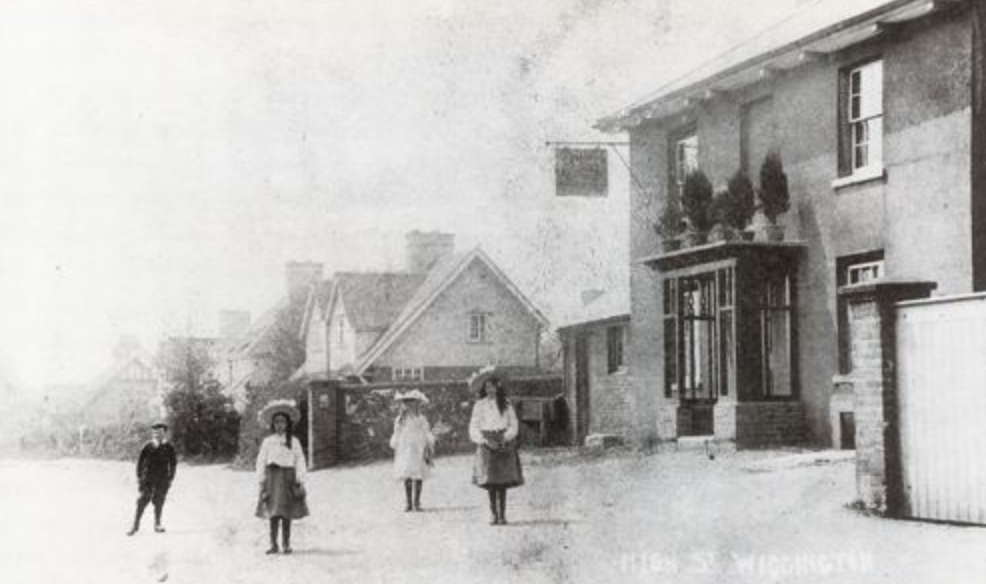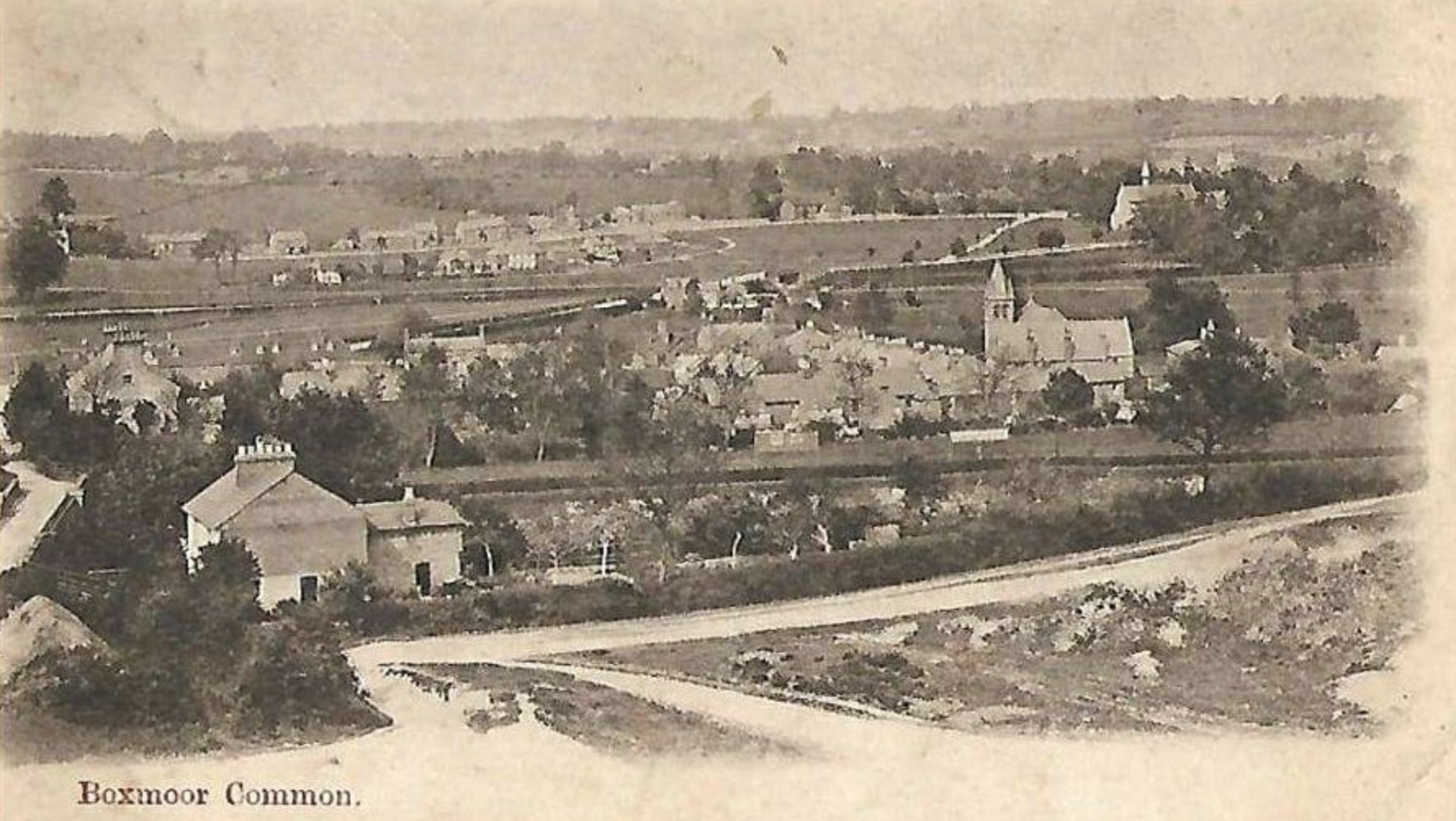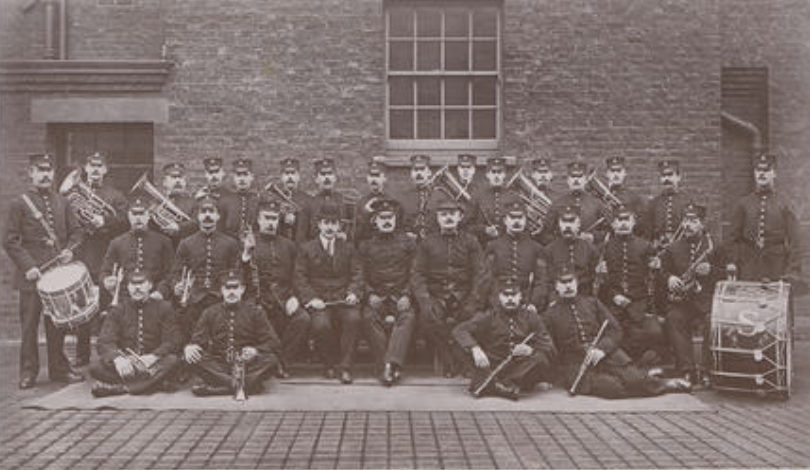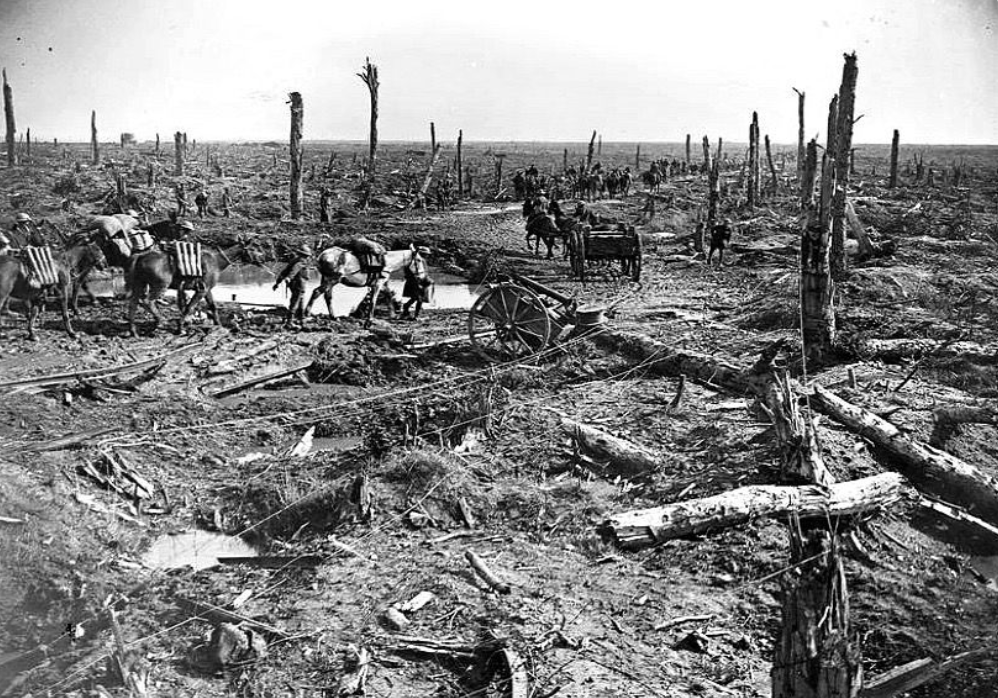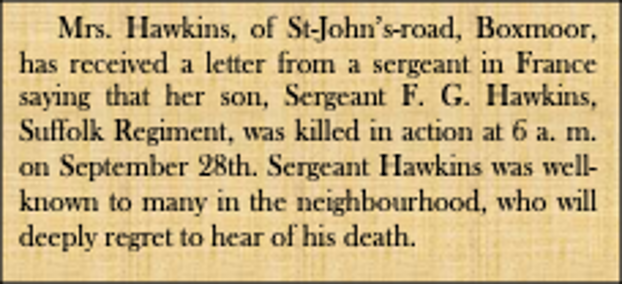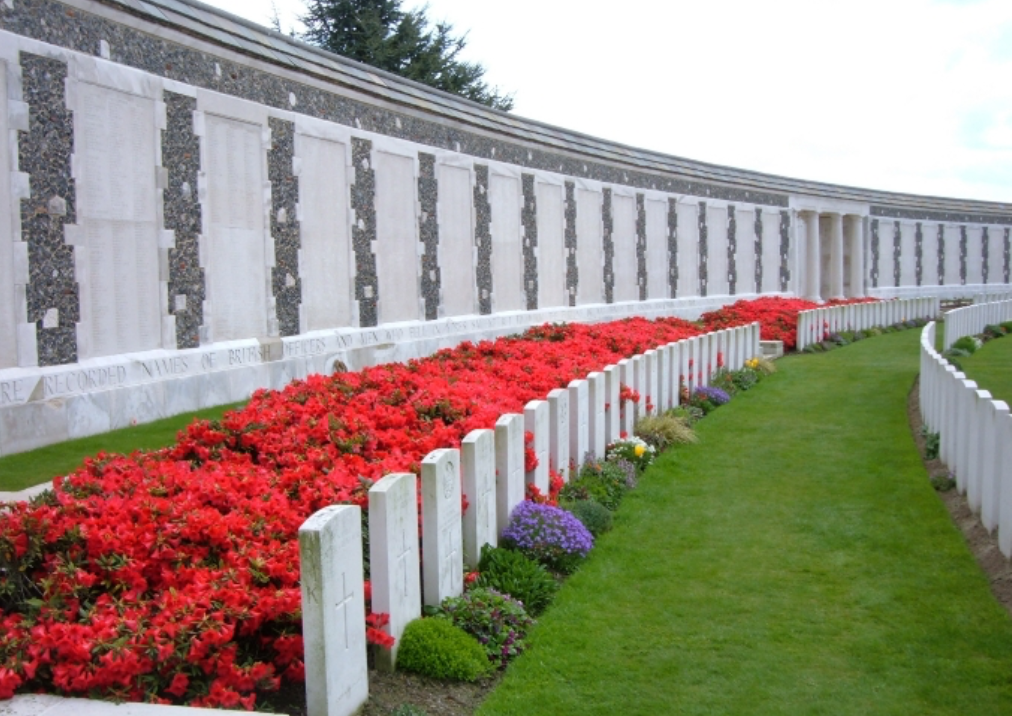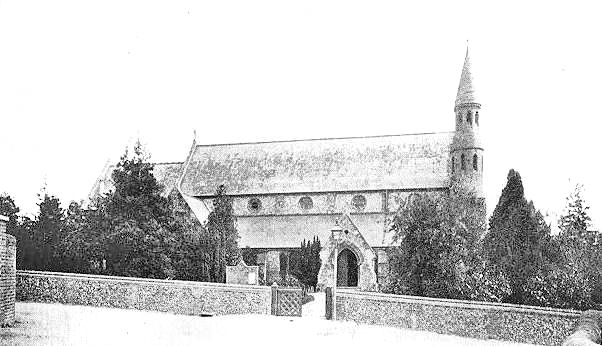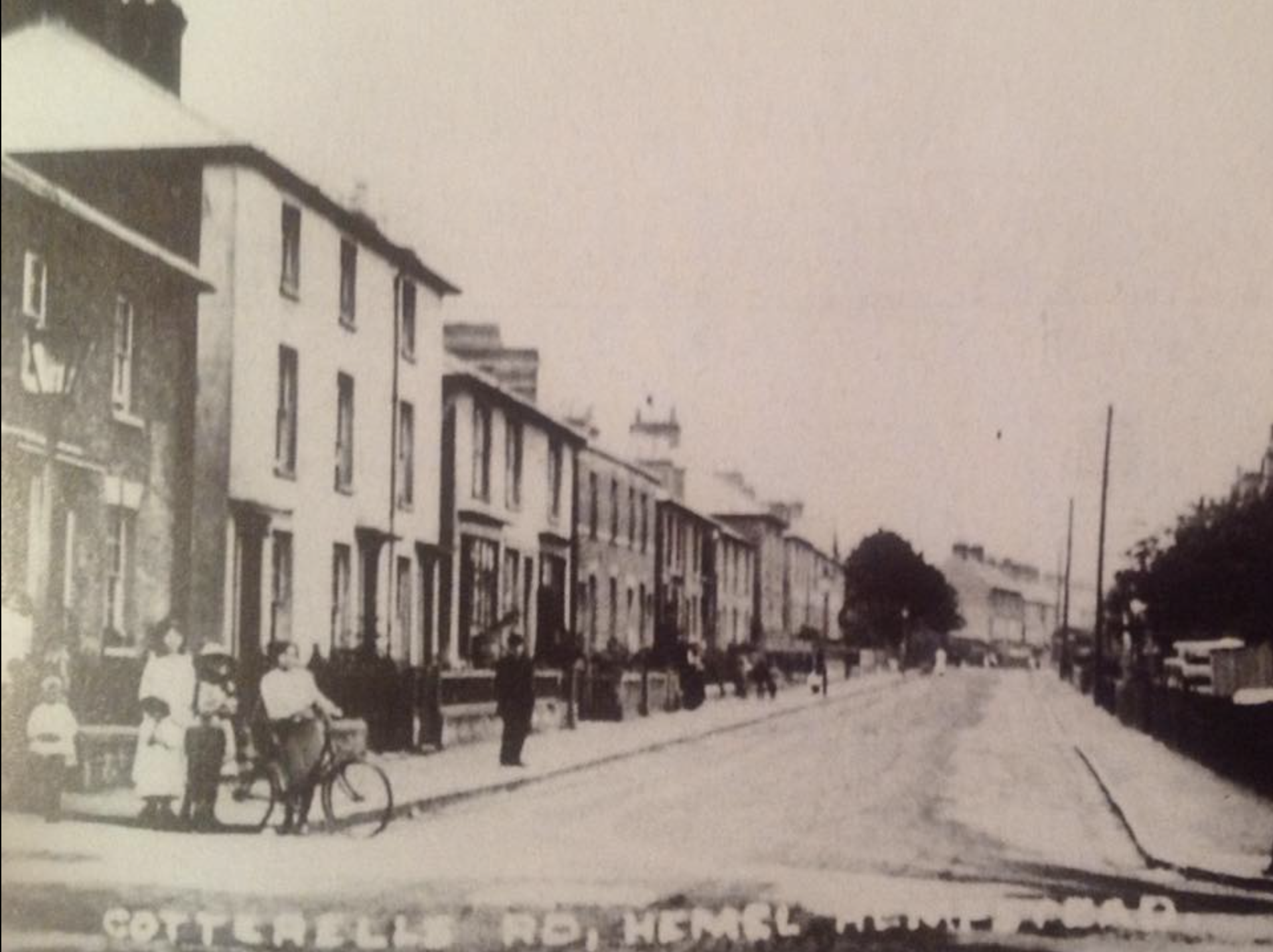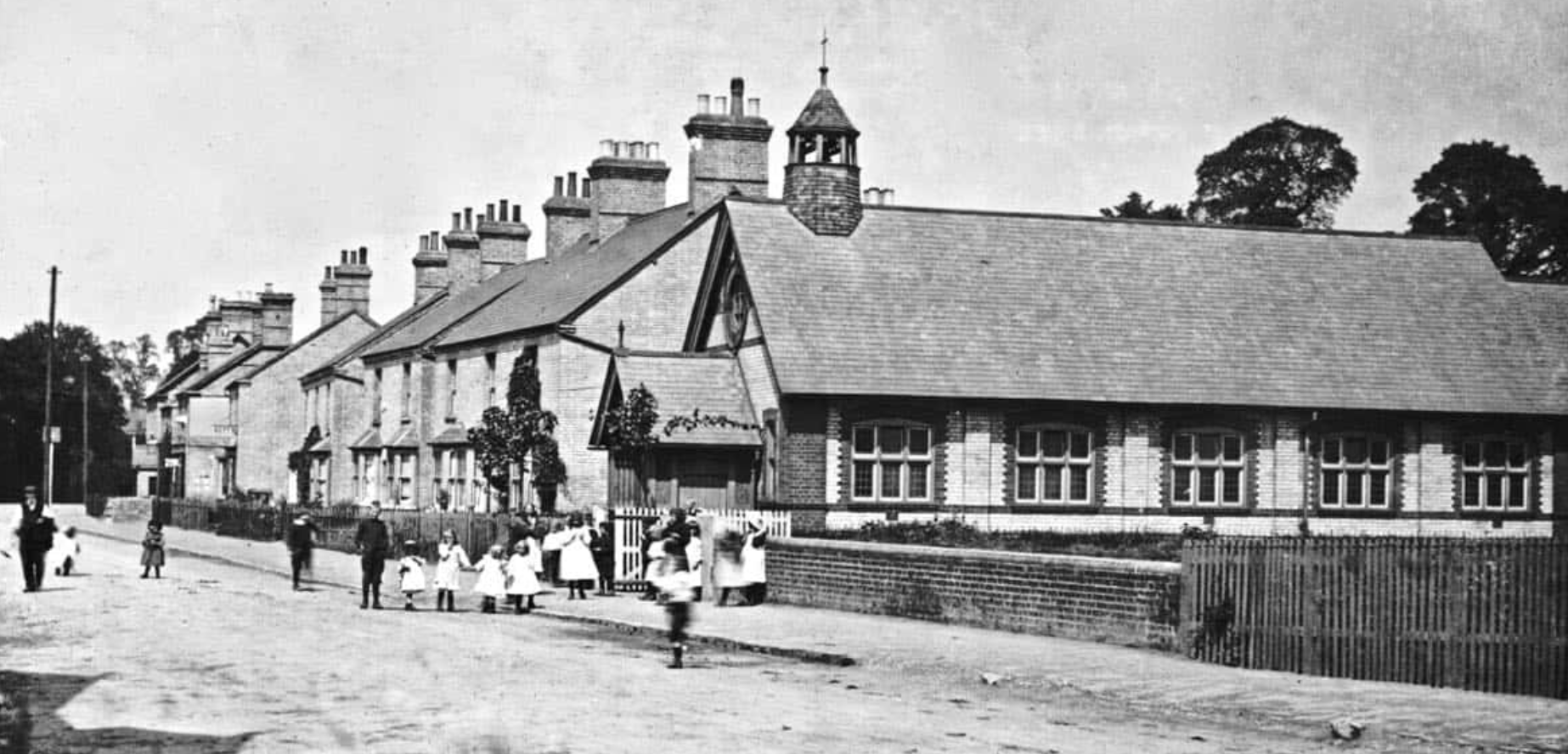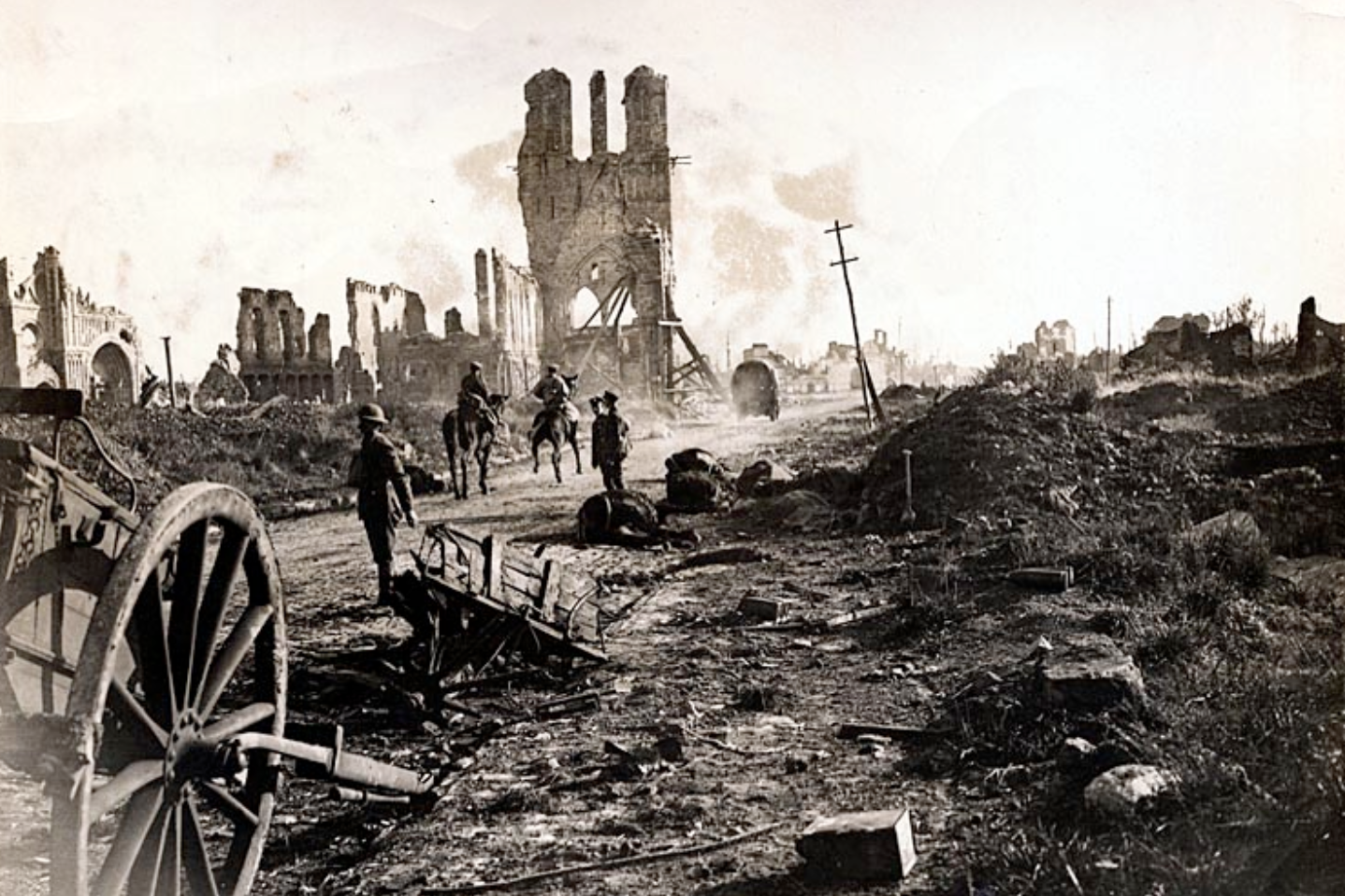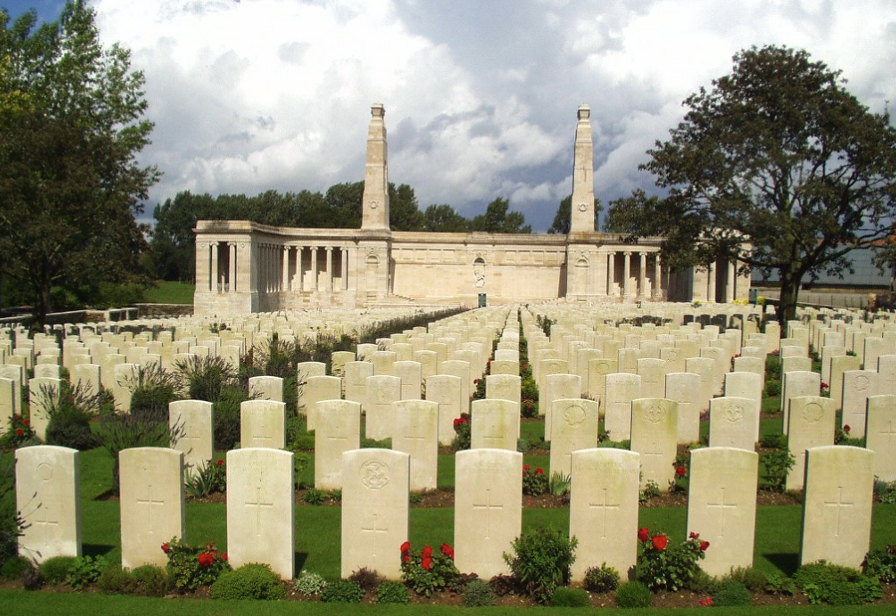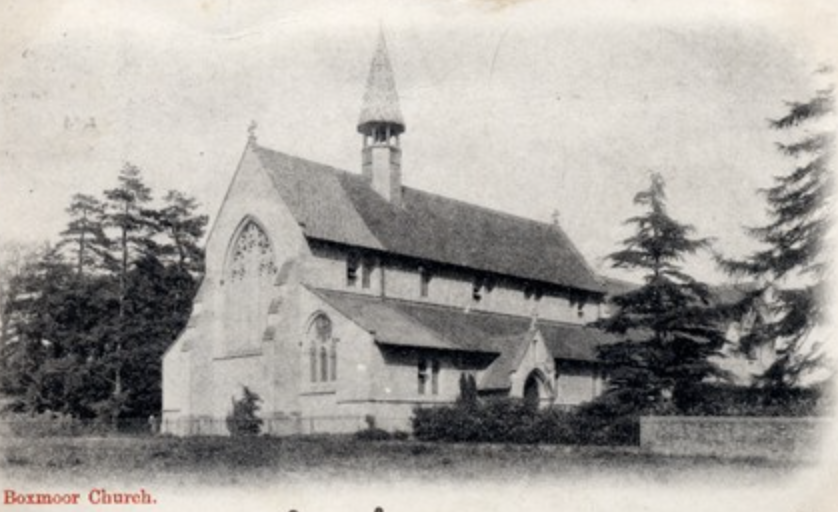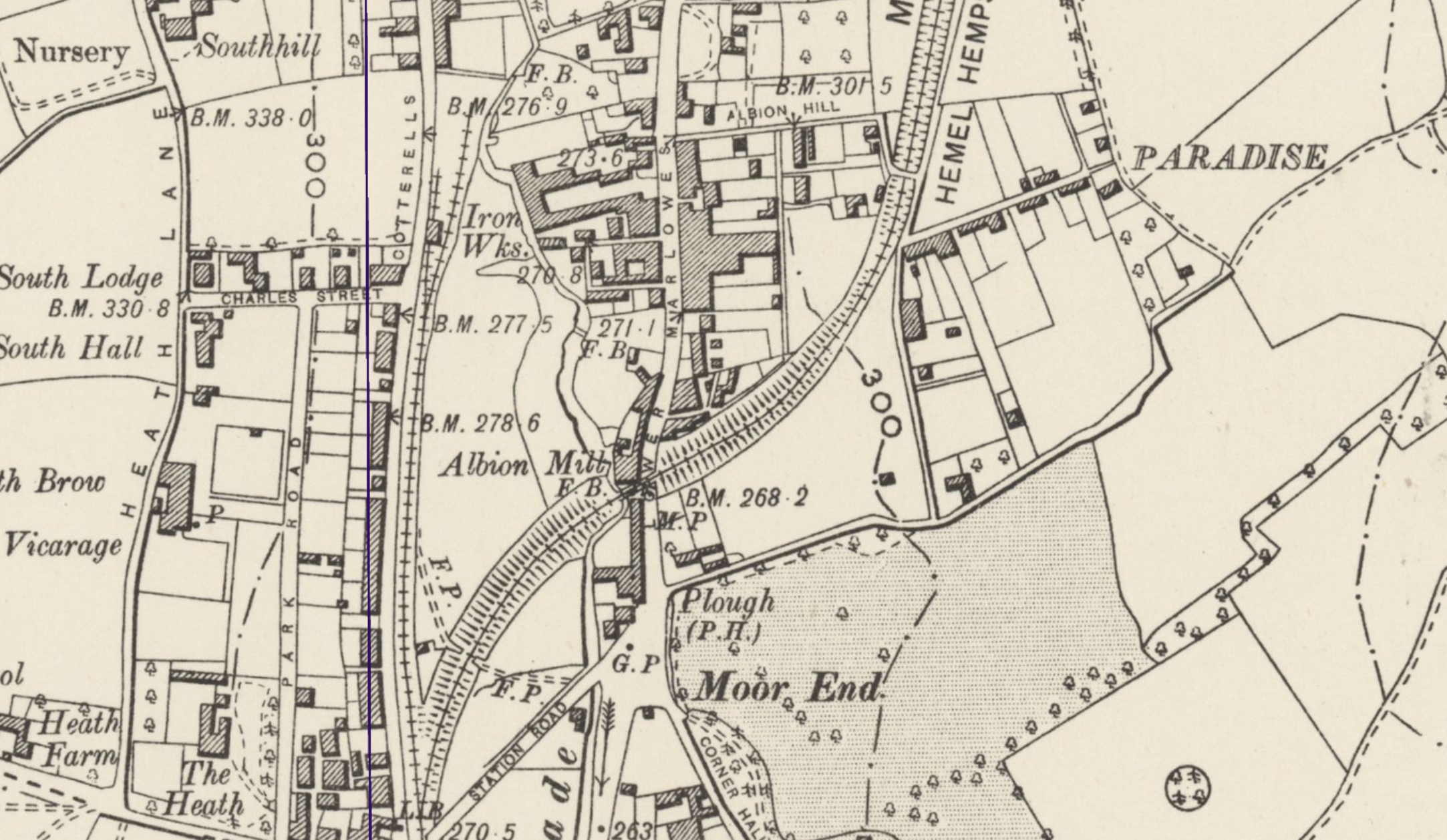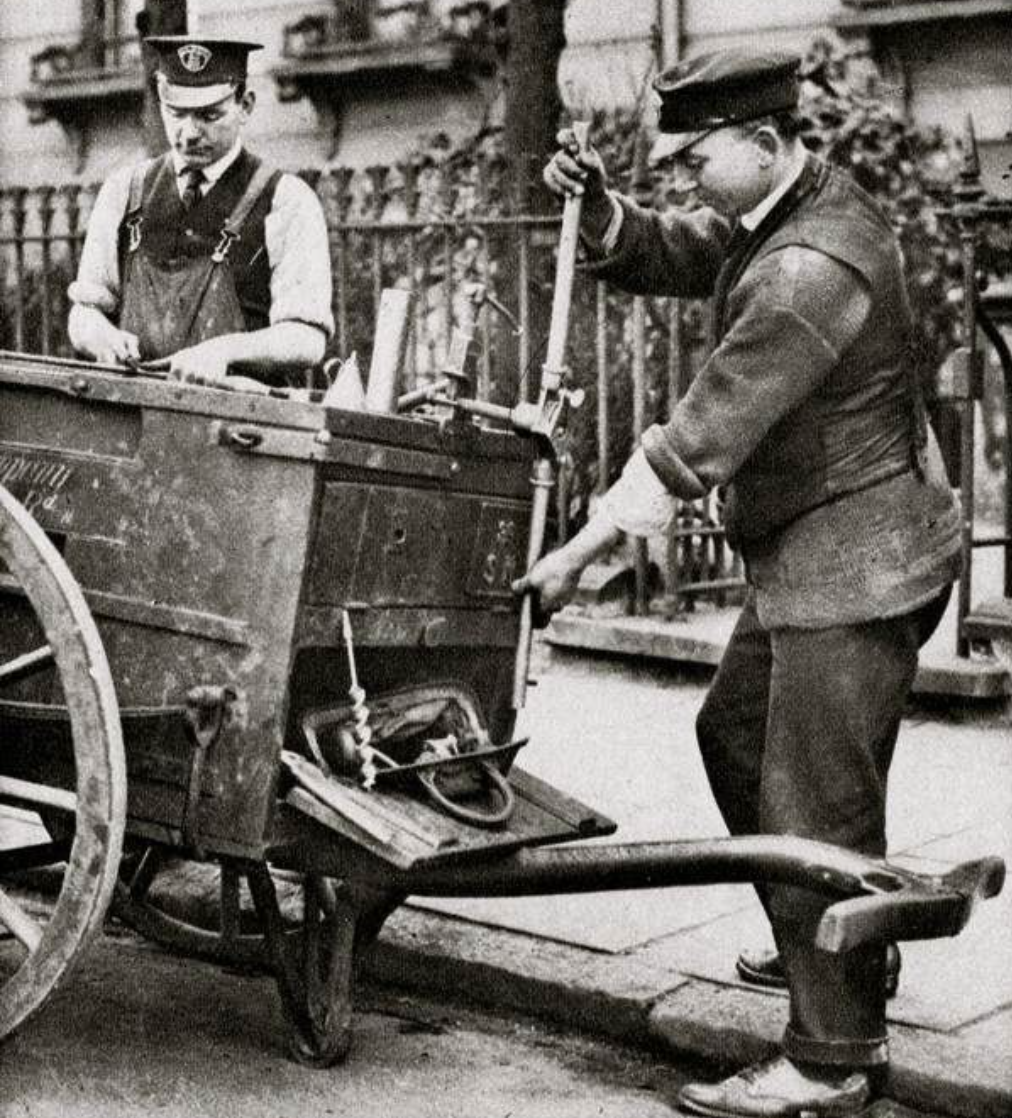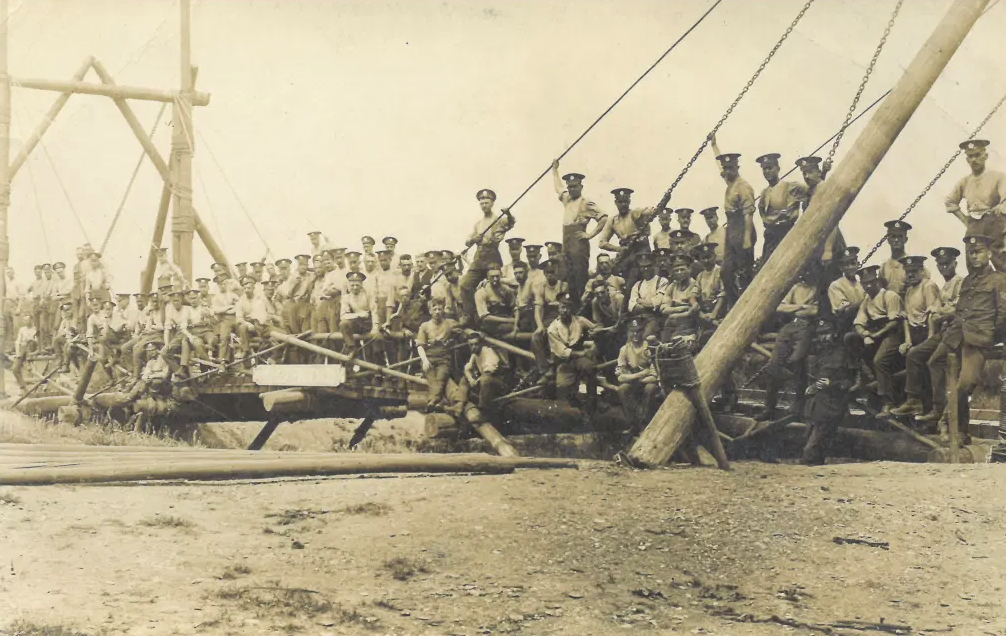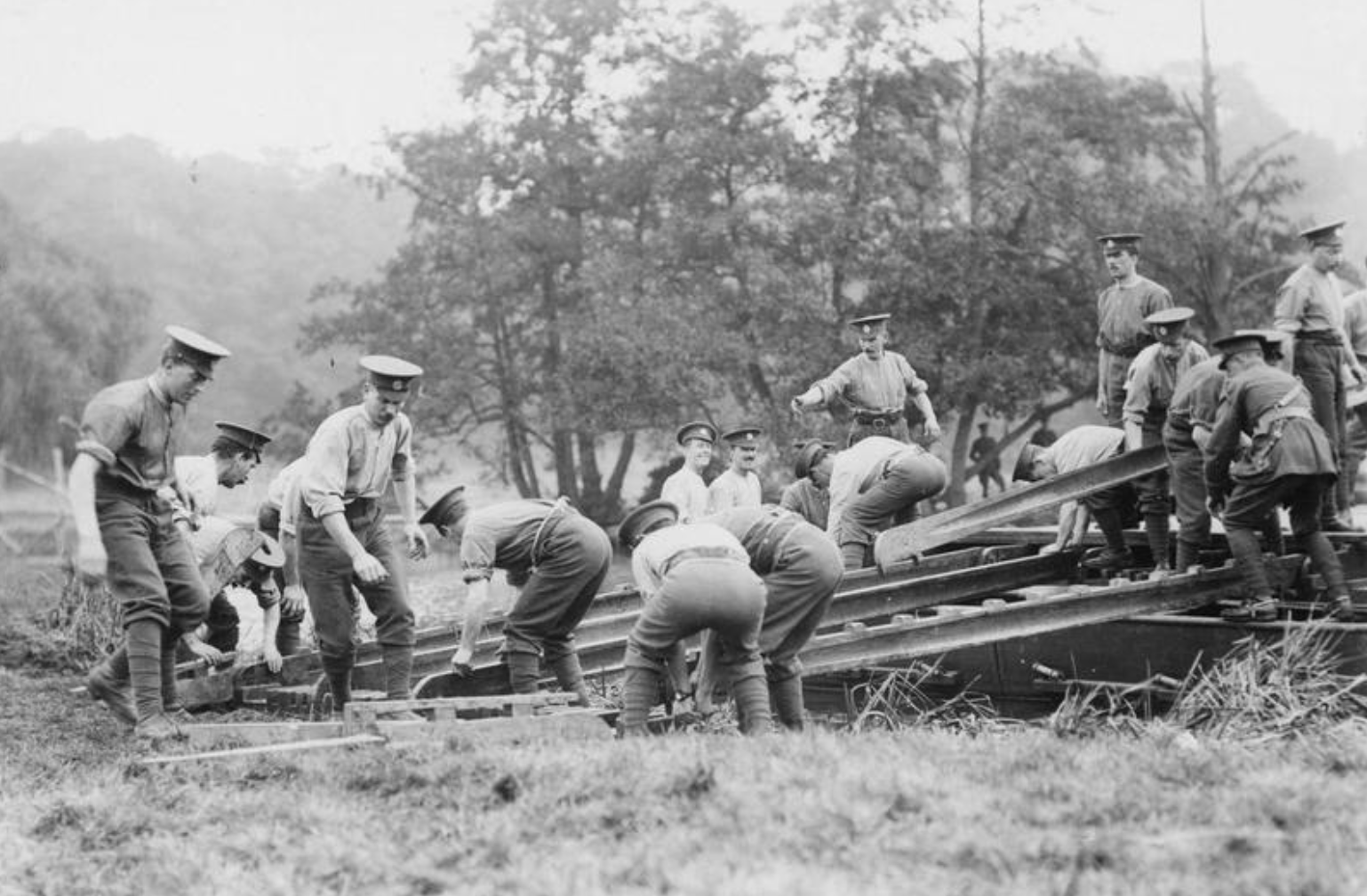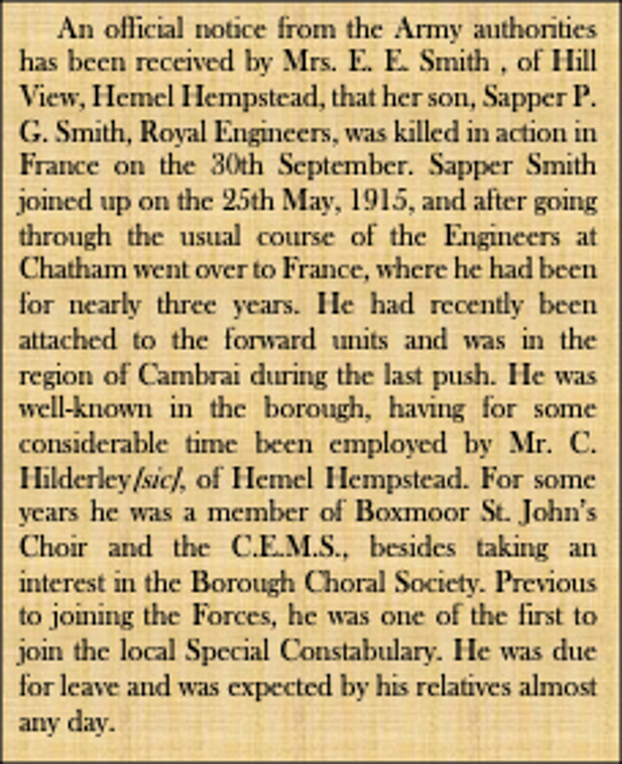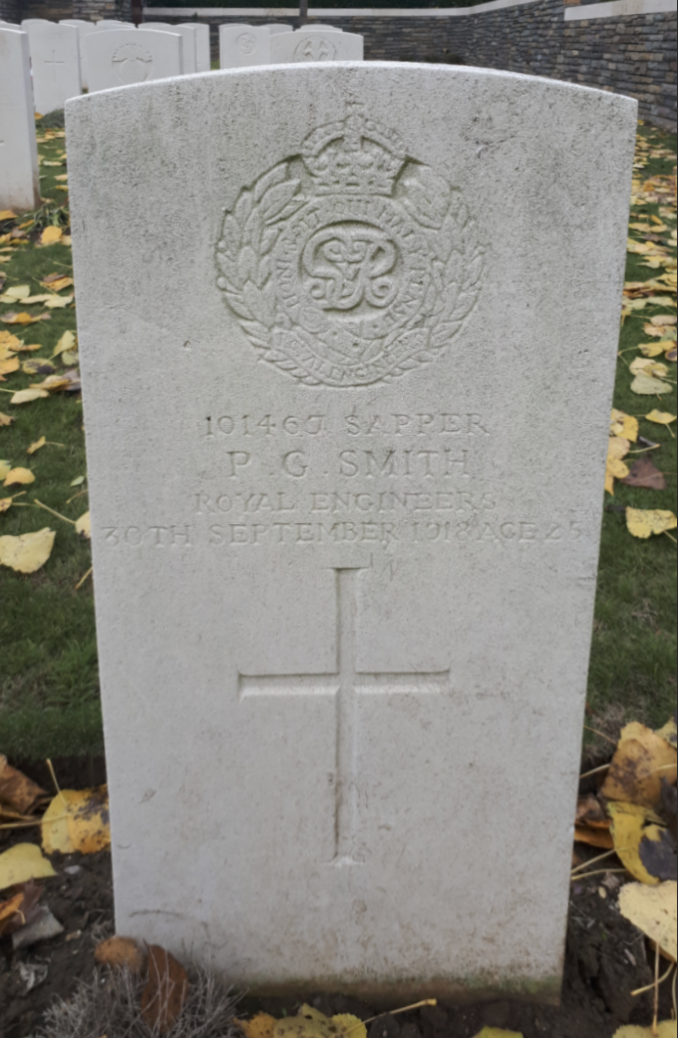Fallen in September 1918:
Montague Crawley
Sidney Richard Elworthy
Walter Chennells
Edward James Godman
Henry Smith
Harry Leonard Hourd
Frederick Arthur Jones
William Piggott MM
Frederick George Hawkins
Arthur Austin
Percy George Smith
MONTAGUE CRAWLEY
235230 Private
17th Bn., Royal Welsh Fusiliers
Killed in Action Sunday, 1st September 1918
Remembered with Honour, Vis-En-Artois, Pas de Calais, France, Panel 6.
Montague Crawley was born in Boxmoor, Hertfordshire on Monday, 6th February 1893 the ninth child of Daniel Crawley and Annie Birch. Daniel and Annie had a total of eleven children who were Annie Elizabeth, Alice Mary, Herbert William, Daniel, Florence Louisa, Percy Dean, Alfred, Lily, George, Montague and Harold. Lily died in infancy in 1889 and Alfred died in 1902 aged sixteen. Montague’s brother George fought and died in the Great War on the 1st July 1916 and his biography also appears on this site.
The Crawley family lived on Cowper Road in Boxmoor for more than fifty years and when Montague was born his father was working at nearby Foster’s Sawmills on Kingsland Road.
The children all attended Boxmoor JMI School and Montague started his education in the Infants department in 1897 before moving into the main school in February 1900. A note in the Headmaster’s Log in 1903 records that along with three other pupils, Montague and his older brother George were “…working illegally…(employed by shop-keepers)…” as a result the average attendance in the classroom during that particular week was an astounding “56.5”. Nevertheless, Montague did well at school and successfully completed four of the seven “Standards” by the time he left at the end of January 1906.
He went straight into Apsley Mills to work for John Dickinson & Co., Limited but he had changed employment by 1911 and had moved to Frogmore Mills where he worked for the British Paper Company. He was still working there on the outbreak of war and following the passing of the National Registration Act in July 1915, after which he had to register and give full employment details, he volunteered before being called.
The Government had warned that voluntary enlistment would cease by 15th December 1915 so Montague travelled to Hertford where he attested on the 23rd October and joined the Hertfordshire Regiment. He was immediately posted to the 3rd/1st Battalion for basic training at Halton Camp, Wendover (now RAF Halton) and on the 5th July 1916 he was sent overseas.
He was posted first to the 1/1st Hertfordshire Regiment known as the “Hertfordshire Guards” but rather than being sent to his unit in the front lines he was transferred to No.3 Entrenching Battalion at the Base Depot in Boulogne. These Entrenching Battalions were formed to undertake work on rear defences near the front lines and were often used as a pool of reinforcements for conventional infantry battalions.
Montague remained with this unit for almost a year when he was transferred to the 4th (T.F.) Royal Welsh Fusiliers before being posted to the 17th Battalion Royal Welsh Fusiliers when he went into the front line. Just over a month later on the 31st July he was wounded by a gunshot wound to his hand and taken out of the line for treatment.
He returned to the Base Depot a week later and by the end of August he had gone back to his Battalion in the field. On the 19th September he was granted ten days leave and he returned to Hemel Hempstead to see his family and friends. By the end of October he was back in France with the 17th Royal Welsh.
During 1918, Montague spend much time in the trenches with his comrades, mainly is support of other units, however, in August, he fought in the Battle of Albert which was significant as the opening push in a series of actions which ultimately brought the war to a successful conclusion for the Allies. Only a few days later Montague was again in action at the Battle of Bapaume, and it was here that his luck finally ran out.
On the 1st September, the Battalion attacked the German positions near Morval and despite progress it was forced to fall back after supporting units failed to keep pace. Despite being outflanked the 17th Battalion still captured prisoners in large numbers but also suffered some casualties in the attack. Thirty-two men fell and one of these sadly was Montague.
He was Killed in Action on Sunday, 1st September 1918.
A brief report of his death was published in the Hemel Gazette six weeks after he was killed. (see extract)
Montague is Remembered with Honour on the memorial in Vis-En-Artois cemetery, Pas de Calais, France, on Panel 6.
He was 25 years old when he died.
Montague was entitled to the British War Medal and the Allied Victory Medal.
Boxmoor JMI School where Mantague was educated (Image: https://www.peterwagonfinearts.co.uk/)
The British Paper Company at Frogmore Mills where Montague worked before he volunteered (Photo: https://www.frogmorepapermill.org.uk)
National Registration Act 1915 antecedent to conscription (Image: The National Archives)
Entrenching Battalion Headquarters in Bus-les-Artois May 1918. (Photo: Imperial War Museum image Q19546)
Extract from The Hertfordshire, Hemel Hempstead Gazette and West Herts Advertiser 12th Oct. 1918
Vis-En-Artois cemetery, Pas de Calais, France (Photo: CWGC)
SIDNEY RICHARD ELWORTHY
Second Lieutenant
Royal Air Force
Died of Injuries Sunday, 1st September 1918
Remembered with Honour, Hemel Hempstead (Heath Lane) Cemetery, Hertfordshire, United Kingdom, Grave SB. 36.
Sydney Riachard Elworthy, known as Dick, was born in St. Lukes, Finsbury, London on Saturday, 31st October 1891 and baptised on Tuesday, 29th March 1892 at St. Matthew, City Road, Islington. He was the second son of Frederick Frank Elworthy and Harriet Priscilla Combridge who had six children together who were Mary Clarissa, Frederick John, Sydney Richard, George Bruce (known as Bruce), Leonard Maurice and an unknown child who died at birth.
Fred, Bruce and Leonard all served in the Great War and all survived, although Leonard, also a 2nd Lieutenant in the Royal Flying Corps (subsequently the R.A.F.), was reported missing just a week after Dick was buried but turned up safe and well as a prisoner of war in Germany. Leonard served with the R.A.F. for fifteen years rising to the rank of Squadron Leader. He was tragically killed in June 1932 when his parachute failed to open near Andover, Hampshire after he had bailed out of a Boulton Paul P.29 Sidestrand Mk III that had suffered engine failure. He was thirty-seven years old.
Sydney’s father Frederick was a “Veterinary Surgeon” who came from Devon originally, where his own father had also been a “Vet”. He ran a successful practice, first in London where he met and married Sydney’s mother Harriet and where all the children were born. He brought the family to Hemel Hempstead around 1897 when he bought Grove Hill, a large house standing to the north of Hemel Hempstead In rolling farmland and from where he continued to practice his profession. Frederick died on the 4th December 1902 aged forty-one leaving an estate valued at £25,000 (£2.2M today).
Dick and all of his brothers attended Berkhamsted School which he left in 1909 and went into the paper manufacturing business although it is not known if this was with John Dickinsons at Apsley of the British Paper Company at Frogmore Mills. He left this work in 1913 when he sailed for Rangoon on the Herefordshire, a ship of the Bibby Line and his occupation was recorded in the passenger manifest as “Gentleman”. He had in fact obtained a position as a “Planter” on a Tea and Rubber Plantation in Ceylon (Sri Lanka) and this was to be his life until he returned to volunteer for war service.
He applied for a commission with the Royal Flying Corps (RFC) and sailed back to England, where he arrived in May 1917 and was summoned to enlist to undergo the necessary training with an Officer Cadet Unit, in which he would be an “Air Mechanic Third Class”. He was described as being six feet tall and under trade he is listed as a “Miscellaneous aviator”, no doubt associated with his job as a “Tea Planter”. Following successful completion of the instruction course after ninety-nine days, he was awarded a temporary commission as 2nd Lieutenant on the General List and was discharged from his position as an “Air Mechanic”.
His Commanding Officer noted that Dick was of “good” character and was a “Keen and efficient” recruit and on his discharge he was immediately sent to Farnborough, Hampshire to his new unit, attached to the Artillery & Infantry Co-operation School, Worthy Down.
He continued to train and on the 1st April 1918 he was promoted 2nd Lieutenant and awaited posting overseas. Before he could go however, he suffered serious injuries at as the result of a crash when he was flying a Bristol Fighter (C894) on the 31st August. Despite being rushed to St Thomas' Hospital, Winchester for treatment he succumbed to his injuries the following day. A fellow officer, Lieutenant Albert Jacques Tremblay, also died in the crash
Dick died on Sunday, 1st September 1918 and four days later, his body was returned to Hemel Hempstead where he was buried on Friday, 6th in Heath Lane Cemetery.
He was buried in the same grave as his father Frederick and they would both be joined the youngest of the brothers, Leonard in 1932 and by their wife and mother Harriet in 1943 when she died aged eighty-eight.
A series of announcements and reports were published in the Hemel Gazette in the weeks immediately following his death which included a more detailed description of his funeral and internment at Heath Lane Cemetery. (see extract)
He was commemorated on the War Memorial Plaque in St. Mary’s Church, High Street, Hemel Hempstead where he and his family had worshipped.
Dick is Remembered with Honour in Hemel Hempstead (Heath Lane) Cemetery, Hertfordshire, United Kingdom, where he is interred in Grave SB. 36.
He was 26 years old when he died.
Dick was entitled to the British War Medal and the Allied Victory Medal.
Grove Hill where the Elworthy family lived (Image: Grovehill Chronicle)
Extracts from The Hertfordshire, Hemel Hempstead Gazette and West Herts Advertiser 7th Sep. 1918
Extract from The Hertfordshire, Hemel Hempstead Gazette and West Herts Advertiser 14th Sep. 1918
Extracts from The Hertfordshire, Hemel Hempstead Gazette and West Herts Advertiser 12th & 19th Sep. 1918
Dick Elworthy’s Headstone, Hemel Hempstead (Heath Lane) Cemetery, Hertfordshire, United Kingdom (Photo: Traquair Photography)
St. Mary's War Memorial Plaque, High Street Hemel Hempstead Photo: Traquair Photography)
WALTER CHENNELLS
G/75287 Private
10th Bn., Royal Fusiliers
Killed in Action Sunday, 14th September 1918
Remembered with Honour, Fifteen Ravine British Cemetery, Villers-Plouich, Nord, France, Grave VI. E.11
Walter Chennells was born in Queen Charlotte’s Hospital in Kilburn, North London on Saturday, 21st January 1899 and baptised in St Mark’s Church, Marylebone two weeks later, on Thursday, 2nd February. He was the only son of Florence Elizabeth Chennells who was a native of Great Gaddesden in Hertfordshire.
Queen Charlotte's is reputed to be the oldest maternity hospital in Europe having been founded in 1752. Today it is part of Queen Charlotte's and Chelse Hospital.
Walter’s mother Florence was in domestic service and had been working as a “Housemaid” since leaving school. She had worked for Duncan Field a ”Miller” and “Corn Merchant” at Noake Mill near Water End, Hertfordshire, but she had left his employ and moved to London sometime after 1891. After he was born, Walter did not stay with his mother who continued in service, but it is not clear where he went after he was born.
There is a record of a two-year-old Walter Chennells living in Sapcote, Leicestershire with the Brown family as a “Nurse-child”, and this may have been a friend who had taken Walter in to help Florence. Florence in the meantime was working as a “Housemaid” for the Brassey family at Normanhurst Court at Catsfield near Battle in East Sussex, one of sixteen household staff in this large house. Normanhurst Court had been built by Thomas Brassey one of the leading railway builders of the 19th century and was the Brassey family home for many years. It was a military hospital during WW1, later a girls school and finally a prisoner of war camp during WW2.
By 1911 Walter, aged twelve, was living with his Grandmother Martha at “Kemp’s Orchard” near Grovehill in Hemel Hempstead. This was an area which was situated to the east of Piccotts End and at the top of what is now the “Link Road” in Hemel Hempstead and the Grovehill housing development. Walter left school in 1912 but where he went to work is not known, however, as soon as he had reached his eighteenth birthday he travelled to Watford where he volunteered for service.
He attested in March and enlisted in the Army and was posted for basic training to the Training Reserve Battalion based at Dover. The following year when he was old enough to go overseas, he was posted to the 17th Battalion Royal Fusiliers and sailed to France on the 18th February 1918.
Walter was with the 17th Battalion until the 3rd July 1918 when he was posted to the 10th Battalion, a unit originally raised in the financial district of the City of London and known as the “Stockbrokers Battalion”. He arrived shortly before the Battalion went into action in what became known as the “One Hundred Day Offensive” which ultimately led the Allies to victory and the Armistice in November 1918.
Sadly young Walter did not survive to see the end of the war and he fell during the Battle of Albert near Trescault on Sunday, 14th September 1918.
Following his death, Walter’s mother Florence married James Palmer in Stepney, London in 1919 and they moved back to Hemel Hempstead where they lived at “Lane Farm” Cottages just a short way from where Walter grew up at “Kemp’s Orchard”. Florence died in 1957 aged eighty-five and is buried in Heath Lane Cemetery.
His Grandmother Martha who raised him was recorded as his “Mother” on his military records and she sadly died in 1921 at the age of eighty-one, however, not before she ensured that her Grandson was commemorated on the War Memorial Plaque in St. Mary’s Church on the High Street in Hemel Hempstead.
Walter is Remembered with Honour in Fifteen Ravine British Cemetery, Villers-Plouich, Nord, France, where he is interred in Grave VI. E.11
He was only 19 years old when he died.
Walter was entitled to the British War Medal and the Allied Victory Medal.
Kemp's where young Walter lived with his Grandmother "New House" became Grovehill. His mother Florence later lived at Lane Farm (Courtesy: National Library of Scotland: https://maps.nls.uk)
Volunteers of the 10th Royal Fusiliers 'Stockbrokers' at the Tower of London in 1914 (Photo: Getty Images)
St. Mary's War Memorial Plaque, High Street Hemel Hempstead Photo: Traquair Photography)
Fifteen Ravine British Cemetery, Villers-Plouich, Nord, France (Photo: CWGC)
EDWARD JAMES GODMAN
27696 Private
2nd Bn., Bedfordshire Regiment
Killed in Action Monday, 15th September 1918
Remembered with Honour, Chipperfield (St. Paul) Churchyard, Kings Langley, Hertfordshire, United Kingdom
Edward James Godman was born in 1884 in Chipperfield near Kings Langley, Hertfordshire, the seventh child of George Godman and Charlotte Whitney who had nine children together. Edward grew up with seven siblings who were: Alice Mary, George William, William George, Alice Kate, Ruth, Leonard, James and Chris (Christopher). The oldest girl Alice Mary died in 1874 aged three and Edward’s brother Chris fought and died in the Great War on 3rd October 1915. His biography also appears on this site.
When Edward was born the family lived at “Chapelcroft” in Chipperfield and his father George, worked as a farm labourer on a nearby farm and like his two older brother’s he followed his father onto the land when he left school.
He attended Apsley Boys School which he left in April 19897 to begin work as a “Shepherd Boy” before gaining employment as a “Farm Labourer”. This was the job he was doing on the outbreak of war and he remained on the land until the introduction of the Group System (Derby Scheme) in September 1915 which was introduced following the National Registration Act the previous July. He attested in October and on the promise of future service was posted to the Army Reserve until his “group” was called up.
This happened at the end of March 1916 when he travelled to Bedford and enlisted with the Bedfordshire Regiment and immediately sent to undergo basic training. It is not known when he went overseas but it was probably around September 1916 when he was posted to the 2nd Battalion Bedfords. During September and October the Battalion was receiving regular drafts of reinforcements having lost some 440 men in July alone.
If Edward arrived in September or early October he would have fought in the Battle of Transloy Ridge where once again the 2nd Battalions suffered heavy casualties losing 435 men, almost half the unit’s fighting strength. For the next two years the Battalion fought in the major engagements at Arras and Ypres, including Passchendaele as well as the First Battles of the Somme in 1918. Arras, Albert and the Second Battle of Bapaume followed in what became known loosely as the “last 100 days” as these battles moved the Allies to victory and the Armistice in November 1918.
However, it is not clear how long Edward was at the front fighting or if he was wounded or became ill which led to his evacuation back to England and admission to hospital. What is known from his military records is that he was in Colchester Military Hospital in 1918 and it was here that he sadly died on Monday, 15th September, either from wounds or illness.
Edward is Remembered with Honour in Chipperfield (St. Paul) Churchyard, Kings Langley, Hertfordshire, United Kingdom The inscription on his headstone, requested by his father George, reads: “SAFE IN THE ARMS OF JESUS PEACE PERFECT PEACE”
He was 34 years old when he died.
Edward was entitled to the British War Medal and the Allied Victory Medal.
"Chapelcroft" a row of three cottages where Edward was born (Image:http://www.hertfordshire-genealogy.co.uk)
Recruits attesting under the Group or Derby Scheme just before the introduction of conscription (Photo: Public Domain)
Colchester Military Hospital where Edward was treated but sadly died (Photo: https://militaryhospitalcolchester1918.wordpress.com)
Edward Godman’s Headstone, Chipperfield (St. Paul) Churchyard, Kings Langley, United Kingdom (Photo: Traquair Photography)
HENRY SMITH
G/31387 Lance Corporal
6th Bn., Queen’s Own (Royal West Kent Regiment)
Killed in Action Friday, 19th September 1918
Remembered with Honour, Vis-En-Artois Memorial, Pas de Calais, France, Panel 7.
Henry Smith was born on Tuesday, 10th January 1899 in Piccotts End just outside Hemel Hempstead and baptised a few weeks later, in St. Mary’s Church on Wednesday, 1st February. He was the youngest child of Harry (Henry) Smith and Rebecca Ayres and his older siblings were Matilda, Hester, Victoria and William Henry along with two other children who sadly died in infancy.
Not long after Henry was born the family moved to Apsley End where his father Harry worked as a “Pedlar” while his mother Rebecca and one of his older sisters, Hester were working in Apsley Mills in the “Envelope Department”.
In 1906 Henry started at Apsley Boys School and joined 123 other pupils in the small two room schoolhouse where he completed his education in 1913. When he left he followed his mother and now his older brother, William, into Dickinsons at Apsley Mills where he remained until he left to volunteer.
As soon as he reached his eighteenth birthday he sought permission to leave his employment and travelled to Watford in March 1917, where he attested and enlisted in the Army. He was posted to a Training Regiment to undergo basic training and found himself in “A” Company of the “Young Soldiers” Battalion at Shoreham on the south coast, attached to the Royal Sussex Regiment before being posted to a “Graduated” Battalion to complete his training before he was sent overseas.
Following the introduction of conscription in 1916, the old regime of reserve battalions could not cope with the numbers of new recruits, so a new structure was put in place which meant the process of basic training was centralised and rather than enlisting with a local regiment, new soldiers were allocated to units most in need when their training was complete.
When Henry went overseas sometime early in 1918, he was posted to the 6th Battalion Queen’s Own (Royal West Kent Regiment). The Queen’s came under the orders of the 37th Brigade in the 12th (Eastern) Division and had seen action in most of the major battles in the Somme and Arras sectors since 1915. During one thirty-seven-day period between December 1915 and January 1916, the Division had suffered 772 casualties during a “quiet period” of trench holding.
When Henry joined his Battalion in 1918 he was quickly in action when he fought in the Battles of Bapaume and Albert in March, phases of the First Battles of the Somme 1918. The 12th Division once more suffered heavy casualties, some 1285 men lost, and April and July were periods of rebuilding.
Sir Arthur Conan Doyle famously said in his in his “British Campaign in France and Flanders, January to July 1918” of the Division’s role in March and April that they “withdrew from the line in glory, for it is no exaggeration to say that they had fought the Germans to an absolute standstill”. He was correct, the enemy offensive in Picardy had finally been defeated.
The Battles of Amiens and Albert followed in August both of which Henry survived, but in mid-September the Queen’s were in action in the area of Manancourt attacking stubbornly held enemy strongholds. Over a few days and despite heavy casualties resistance was overcome and objectives achieved.
Sadly, however, Henry was killed in this fighting and he died on Friday, 19th September 1918.
He was commemorated on the War Memorial Plaque in St Mary’s Church, Apsley End and nearby on the John Dickinson & Co., Limited War Memorial. He was also commemorated on the War Memorial Plaque at the Church of St. Mary and St. Joseph in Boxmoor.
Henry is Remembered with Honour on the Vis-En-Artois Memorial, Pas de Calais, France, Panel 7.
He was only 19 years old when he died.
Henry was entitled to the British War Medal and the Allied Victory Medal.
St. Mary's Church, Hemel Hempstead where Henry was baptised (Photo: http://www.hertfordshire-genealogy.co.uk)
One of the training camps at Shoreham-by-Sea (Photo: Marlipins Museum, Sussex Archaeological Society)
War Memorial Plaque Church of St. Mary and St. Joseph, Boxmoor (Photo: Traquair Photography)
Vis-En-Artois Memorial, Pas de Calais, France (Photo: CWGC)
HARRY LEONARD HOURD
57712 Private
2nd Bn., Worcestershire Regiment
Died of Wounds Tuesday, 24th September 1918
Remembered with Honour, Five Points Cemetery, Lechelle, Pas de Calais, France, Grave A. 4.
Harry Leonard Hourd was born Harry Leonard Stevenson in Hickling, Nottinghamshire in August 1899 and baptised at St Luke Church on Friday, 22nd November 1901. His mother was Agnes Winifred Stevenson who lived at home with her mother Caroline and worked as a “Laundress”.
In 1906, Harry’s mother Agnes married Robert Hourd from nearby Upper Broughton and they had two children together. Harry’s half-sisters were Norah born in 1908 and Dorothy May born in 1910. Just a year after Dorothy’s birth, Harry’s stepfather Robert died leaving Agnes to raise the young family alone.
In the 1911 Census, Harry is recorded under his birth name “Stevenson” and it was not until he enlisted that he used his stepfathers name “Hourd”. He left school in 1914 not long before his mother Agnes married for a second time, and he and his siblings gained a new stepfather, James Guthrie. Only two years after the marriage, Agnes died at the age of thirty-eight.
Harry found work as a “Domestic Servant” and just prior to enlisting he was working as a “Footman’ in the London household of Gaby Deslys at her Kensington home, close to the Albert Hall. Gaby Deslys was a famous French dancer and was a huge star in theatre and early cinema during the Edwardian period and throughout the Great War. When she died in 1920 of complications from “Spanish Flu”, here estate was value at the astronomical sum of twelve million Francs.
On the outbreak of war, Harry was still too young to enlist, but as soon as he reached his eighteenth birthday, he volunteered for service. He attested in London, although he was living in Manchester, but this may have been because his employer was performing there at the time.
He was posted for basic training to the 19th Middlesex Regiment at Aldershot and in around March 1918 he was sent overseas posted to the 2nd Battalion Worcestershire Regiment. Harry spent the next six months in and out of the front line as the Battalion fought, first around Ypres, before moving to France.
In September, during another stint in the trenches, Harry was wounded and taken out of the line for treatment. Sadly however, his injuries proved too serious, and he succumbed.
He died of his wounds on Tuesday, 24th September 1918.
Shortly after his death his sister Norah, who can only have been about ten years old, received a letter from the Battalion Chaplain which contained the following: “I am afraid that nothing I can say will lighten your great sorrow, but I pray that our great Father in Heaven will comfort and console you and yours. I am sure that he has followed Lord Jesus Christ along the way of the Cross and will find the Master on the other side and will hear the words “Well done, good and faithful servant”. May the knowledge that he still lives in Christ comfort you. II buried him at 2pm in the British Soldiers Cemetery here, where he lies with the other gallant boys.”
Research has failed to uncover any evidence that Harry ever lived in or visited Hemel Hempstead and the only possible link identified might be one John Thomas Stevenson. He may be the same John T Stevenson named as one of Harry’s beneficiaries on the “Register of Effects” document issued by the War Office in 1919 detailing where a fallen soldier’s effects, pay and war gratuity should be sent. John Stevenson was recorded living at 10 Christchurch Road in Hemel and he may be the person who ensured that Harry was commemorated on the town War Memorial.
Harry is Remembered with Honour in Five Points Cemetery, Lechelle, Pas de Calais, France, where he is interred in Grave A. 4.
He was only 19 years old when he died.
Harry was entitled to the British War Medal and the Allied Victory Medal.
St. Luke's Church, Hickling where Harry was baptised (Photo: Public Domain)
Harry's employer just before he enlisted, Gaby Deslys (Photo: Public Domain)
Pte. Harry Hourd’s Headstone, Five Points Cemetery, Lechelle, Pas de Calais, France (Photo: Traquair Photography)
FREDERICK ARTHUR JONES
30590 Private
7th Bn., Queen’s Own (Royal West Kent Regiment)
Died of Wounds Tuesday, 24th September 1918
Remembered with Honour, Abbeville Communal Cemetery Extension, Somme, France, Grave IV. F. 15.
Frederick Arthur Jones was born in Farnbourgh, near Dartford, Kent in 1882 son of Henry Jones and Emma Hopkins who had a large family of eleven children together. Frederick’s siblings were Maria, Emma, Maud, Harry, Lizzie (Elizabeth), Mary Ann, Herbert, Florence, Alfred and Bessie.
The family lived in Hammerfield when it first arrived in Hemel Hempstead in about 1890 and Frederick’s father Henry worked as a “Gardener”. By 1901 and following his father Henry’s untimely death, the family had moved to South Hill Road and with the exception of Frederick’s mother Emma and the two youngest children, he and his siblings were all employed in Apsley Mills with John Dickinson & Co., Limited.
Frederick left Dickinsons the following year and went to work at G. B. Kent and Sons Limited in the Brush Factory at Frogmore in Apsley. He remained with the firm, where he worked as a “Brush Finisher”, until he left to go to war sixteen years later.
It was in the early 1900s that Frederick met his future wife Annie Rammell Adams a native of Totnes, Devon who had come with her family to Hemel Hempstead in the 1890s when her father George, came to run a pub at Two Waters in Boxmoor. He also had a “Fried Fish Shop” as these were gaining popularity outside seaside towns as the railways brought fresh fish to towns and cities and “fish and chips” became the first takeaway meal.
Frederick and Annie became sweethearts, and they were married in St. Mary’s Church, Apsley End in the summer of 1909 and they set up home on Ebberns Road in Apsley. Their only child, a son, was born in May 1913 and named Leslie George Arthur.
Frederick’s work at the brush factory was “starred”, in other words considered vital to the war effort. Indeed Kent’s Brushes undertook government contracts to supply products such as toothbrushes to the services and this along with his marital status kept Frederick at home.
However, he made the decision to enlist voluntarily in 1918 when he attested at Hertford on the 3rd April and joined the Army. He was immediately posted for training and only five months later on the 7th August he was sent overseas and posted to the 7th Battalion Queen’s Own (Royal West Kent Regiment).
Frederick’s time at the front was tragically brief and he was with his unit for only six weeks when he fell. His death was made more poignant so close to the Allied victory and the Armistice in November.
He was wounded in action in fighting near Ronssoy, south of Cambrai and he succumbed to his injuries on Tuesday, 24th September 1918.
Shortly after his death a brief report along with his picture was published in the Hemel Gazette. (see extract)
Extract from The Hertfordshire, Hemel Hempstead Gazette and West Herts Advertiser 10th Oct. 1918.
Annie went back to her hometown of Totnes with young Leslie, and remarried in 1919 to Reginald Savage who had also fought in the Great War.
Frederick is commemorated on the War Memorial Plaques in G. B. Kent and Sons and in St. Mary’s Church, Apsley End.
He is Remembered with Honour in Abbeville Communal Cemetery Extension, Somme, France, where he is interred in Grave IV. F. 15.
He was 36 years old when he died.
Frederick was entitled to the British War Medal and the Allied Victory Medal.
Pte. Frederick Jones c1918 (Photo: The Hertfordshire, Hemel Hempstead Gazette and West Herts Advertiser)
St. Mary's Church, Apsley End where Frederick and Annie married in 1909 (Photo: http://www.hertfordshire-genealogy.co.uk)
Extract from The Hertfordshire, Hemel Hempstead Gazette and West Herts Advertiser 12th Oct. 1918
Honour, Abbeville Communal Cemetery Extension, Somme, France (Photo: CWGC)
WILLIAM PIGGOTT MM
23271 Corporal
1st Bn., Queen’s Own (Royal West Kent Regiment)
Killed in Action Friday, 27th September 1918
Remembered with Honour, Gouzeaucourt New British Cemetery, Nord, France, Grave V. D. 14.
William Piggott, known as Willie, was born in Stanbridge, Bedfordshire in 1888 the oldest child of William Piggott and Rosa Philpot who had six children together. They were William, Flossie, Lily, Frederick, Ernest and Horace Thomas.
His father, William Snr., worked as a “Labourer” at the Lime Kilns near Totternhoe in Bedfordshire when Willie was born and by 1901 he had additionally started to trade as a “Corn Meal Dealer”. Willie went to Totternhoe Lower School in 1892 he appeared in the school log as an absentee on 8th November, due to “having a bad cold & rash”.
In 1899 the Piggott children all contracted “Scarlet Fever” and as a result were away from school for some time, but thankfully they all recovered. By 1911, Willie was living in Aylesbury, Buckinghamshire where he worked as a “Journeyman Compositor” in the printing trade and was a “Boarder” with the Welford family on Park Street in the town.
The following year he had moved to Hemel Hempstead and started work in Apsley Mills with John Dickinson & Co., Limited as a “Compositor” in the Book Department Composing Room. It was in Apsley Mills that he met his future wife Minnie Saunders, a native of Eaton Bray, and whose entire family worked for Dickinsons. She worked as a “Paper Folding Machine Operator” and she and Willie soon became sweethearts and just a year later they married in St. Mary’s Church, Apsley End before setting up home on Ebbern’s Road in the village.
Willie was a popular figure both at work and in village social life. He was a keen sportsman and an energetic member of the committee of the Apsley Club and Institute and is described as endearing himself to the members “…by his cheery manner, unfailing good humour, and ever ready help in any of the projects associated with the club.” He was also a member of the Hemel Hempstead Co-operative Society and a popular and active member of the Printers Trade Union.
Wille volunteered under the Group (Derby) Scheme and was called up for service on the 1st July 1916 when he travelled to Watford to join the Army. He was immediately posted for basic training near Dover with the “Buffs”, the Queen’s Own (Royal West Kent Regiment). Four months later on the 21st October he was sent to France and posted to the 1st Battalion Royal West Kents.
He fought through the rest of the year and into 1917 where he was in action at Vimy Ridge where the Canadians successful took control of the ridge and captured over 4000 enemy prisoners. Later that year in November, the West Kents moved to Italy and in March 1918, Willie was granted home leave and he immediately returned to Hemel Hempstead to see family and friends.
He returned to Italy at the end of March and then moved with his battalion back to France were at the end of June he was mentioned in dispatches for an act of gallantry. A month later he was promoted full Corporal for “…taking his gun across a canal and clearing a trench…”. Then on the 16th September he was awarded the Military Medal “for some exceptional work in the field” but, sadly only eleven days later Willie made the supreme sacrifice.
During an attack he was wounded, but pushed on, and when all his officers and sergeants had themselves become casualties, he rallied the remaining men in the company and led them against the German position in the face of heavy machine gun and shell fire. He was hit a second time and was killed instantly.
He died on Friday, 27th September 1918.
Following his death, his photograph, a letter from his Commanding Officer and a detailed report about his service and how he fell, were published in the Hemel Gazette. (see extract)
Minnie did not remarry and in later years worked as a “Church Attendant" until she died in 1942 aged fifty-five.
Willie was commemorated on the John Dickinson & Co., Limited War Memorial and on the War Memorial Plaque in St. Mary’s Church in Apsley End
He is Remembered with Honour in Gouzeaucourt New British Cemetery, Nord, France, where he is interred in Grave V. D. 14. The inscription on his headstone, requested by his widow Minnie, reads: “FAITHFUL UNTO DEATH HIS DUTY WELL AND NOBLY DONE.”
He was 30 years old when he died.
Willie was entitled to the British War Medal and the Allied Victory Medal.
Crpl. Willie Piggott c1918 The Hertfordshire, Hemel Hempstead Gazette and West Herts Advertiser
Extract from The Hertfordshire, Hemel Hempstead Gazette and West Herts Advertiser 2nd Nov. 1918
The Military Medal (Photo: https://www.northeastmedals.co.uk)
Willie Piggott’s headstone, Gouzeaucourt New British Cemetery, Nord, France (Photo: Traquair Photography)
FREDERICK GEORGE HAWKINS
63419 Serjeant
12th Bn., Suffolk Regiment
Killed in Action Saturday, 28th September 1918
Remembered with Honour, Tyne Cot Memorial, West-Vlaanderen, Belgium, Panel 40 to 41
Frederick George Hawkins was born in Wigginton, near Tring in Hertfordshire in 1893 the first child and oldest son of George Hawkins and Elizabeth Aves Durrant. He had one sibling, a sister, Aves Mary born two years after him.
His father George brought the family to Hemel Hempstead when he came to work as a “Cattle Herdsman” for the Boxmoor Trust and in 1901 they were living in the “Herdsman’s Cottage” which was situated close to Boxmoor & Hemel Hempstead Railway station.
By 1911, the family had moved to 24 St. John’s Road, Boxmoor and Frederick was working as a “Envelope Cutter” in Apsley Mills for John Dickinson & Co., Limited. His father George now a “Farm Bailiff” was recorded as an “Invalid” and his sister Aves was in secondary education at the age of sixteen.
Frederick left Dickinsons after the 1911 Census and travelled to London where he joined the Metropolitan Police on the 25th May 1914 and was allocated warrant number 103908 and his divisional or collar No. was 984S. He was posted to “S” Division based in Hampstead in No. 2 District. He served with the police until 1916 when he took the decision, as did many serving police officers, to leave and volunteer for service.
He attested at Whitehall in July 1916 and was immediately posted for basic training with the 3rd Reserve Battalion Norfolk Regiment at Felixstowe before being sent overseas at the end of the year. When he went to France he was posted to the 1st Battalion Norfolks and appears to have arrived with one of a series of drafts through January 1917. The new arrivals were still considered “untrained” in battlefield conditions, so they were all dispatched to the Brigade Training Depot.
Frederick was back with the Battalion by the end of February and was soon in action in the frontline trenches and during his time with the battalion he was promoted Sergeant. It is not clear how long he stayed with the Norfolks but he transferred at some point in 1916 to the 1st Battalion Essex Regiment which had returned from Gallipoli in March of that year. It seems likely that this was a result of being wounded as the Norfolk Regiment recorded regular departures of wounded men each month throughout the year.
He was transferred a second time in June 1918, this time to the 12th Battalion Suffolk Regiment and again this may have been due to being wounded. The 12th Suffolks had been reduced to cadre strength and returned to England in June 1918 to rebuild and this would have meant experienced officers, NCOs and soldiers joining the unit prior to a return to France. This happened on the 5th 1918 when the battalion landed at Boulogne under the orders of the 43rd Brigade in the 14th (Light) Division.
The Battalion moved as part of the Second Army to the Ypres sector as soon as had landed at Boulogne and would see out the rest of the war in Belgium. Frederick spent July and August training soldiers in the rebuild unit having been promoted Sergeant again and was back on the frontlines near Ypres in early September.
On the 28th September Frederick fought in what became known as the Fifth Battle of Ypres when the 12th Suffolks were in support of the main attack. The Battalion War Diaries recorded the following: “Although battalions very weak and the men belonged almost entirely to “B” Category, yet they were filled with keenness and confident of success. They moved across the ground with energy keeping close to the barrage….Enemy showed some determination to hold it [position on a bluff] at first against the frontal attack, but when he perceived the encircling movement he lost heart and gave way.”
Sadly Frederick did not live to enjoy the success of the action and it was later reported that he had been killed at 6 a.m. only half-an-hour into the battle.
He was killed in action on Saturday, 28th September 1918.
He was commemorated on the Metropolitan Police Book of Remembrance in Westminster Abbey and on the War Memorial Plaque in the Church of St. John the Evangelist in Boxmoor, where he and his family had worshipped.
He is Remembered with Honour on Tyne Cot Memorial, West-Vlaanderen, Belgium on Panel 40 to 41.
He was 25 years old when he died.
Frederick was entitled to the British War Medal and the Allied Victory Medal.
High Street, Wigginton in the village where Frederick was born (Photo: http://www.hertfordshire-genealogy.co.uk)
Boxmoor Common where Frederick's father came to work (Photo: https://www.boxmoortrust.org.uk)
Met Police 'S' Division Band just before the Great War (Photo: Public Domain)
Aftermath of the Fifth Battle of Ypres where Frederick fell (Photo: © IWM (Q 11796)
Extract from The Hertfordshire, Hemel Hempstead Gazette and West Herts Advertiser 12th Oct.1918
Tyne Cot Memorial, West-Vlaanderen, Belgium (Photo: CWGC)
ARTHUR AUSTIN
25603 Private
4th Bn., Bedfordshire Regiment
Killed in Action Monday, 30th September 1918
Remembered with Honour, Vis-en-Artois Memorial, Pas de Calais, France, Panel 4 and 5.
Arthur Austin was born in Hemel Hempstead in early 1893 and baptised, along with an older sister Minnie, in St. Paul’s Church on Queen Street in the town, on Friday, 14th April in the same year. Their parents John Austin and Emily Smith had a very large family of fifteen children of whom the following are known, May, Nellie, Minnie, Arthur, Lily, Flora (Florence), Alice Victoria, William James, Winnie (Winifred), Ethel, Ernest and Doris. There was one more unknown child and two other unnamed children who all died young.
In 1901 when Arthur was eight years old he was living with his parents, five sisters and one brother in a small, terraced house at 4 Union Square. This was situated just off Queen Street, across the road from St. Paul’s Church and opposite Hemel Hempstead Union Workhouse. As the family grew his parents moved with all the children to a larger property at 108 Cotterells.
By this time Arthur had left school and started work and he was recorded on the 1911 Census as a “Porter” in a drapery store in Hemel Hempstead, possibly with George Rolph who had a large store at Nos. 85 to 89 High Street, Hemel Hempstead.
Sometime after 1911, Arthur met Ethel Lavinia Field a native of Henlow in Bedfordshire. There are no records of Ethel having been in Hemel Hempstead, so it seems likely Arthur met her when he moved away from the town. The date and reason for his move are not known but his military records show that he was living in Arlesey in Bedfordshire when he volunteered in January 1916. Arlesey was less than two miles from Station Road in Henlow where Ethel lived, and they met at some time after Arthur had moved to the area.
Arthur joined up under the Group System (Derby Scheme) in January 1916 when he attested at Bedford and enlisted with the Bedfordshire Regiment. He was immediately posted to the 4th Battalion at Felixstowe for basic training but in late spring he was granted leave to return to Arlesey and he and Ethel married.
The 4th Battalion was a “Special Reserve” originally assigned to home defence duties around Harwich and also used as a training battalion for new recruits and it regularly sent drafts of men to frontline battalions. However, following the catastrophic losses at the Somme in July 1916, the 4th Bedfords were mobilised for service on the Western Front.
Arthur went overseas with his unit on the 25th July 1916 and disembarked at Le Havre before marching to Houdain and then Coupigny west of Amiens. The Battalion remained there util October when it moved up to Varennes in preparation for its first major engagement.
This was the Battle of Ancre on the 13th November 1916 and although there were 193 casualties, killed, wounded or missing, the assault was successful, and Arthur survived. In early 1917 he fought in the actions at Miraumont and then the Battle of Arras, the Second Battle of the Scarpe and Arleux in April. These engagments were very costly and over 660 men were lost.
In September the Battalion moved to Belgium to the Ypres sector and on the 30th October, Arthur fought in horrendous weather conditions in the Second Battle of Passchendaele. Once more the 4th Bedfords suffered significant casualties, 264 men, but again Arthur came through unscathed.
1918 was spent in support as a second line of defence at the Battles of St. Quentin and Bapaume in March but despite this, the 4th Beds suffered further losses, so much so that the period between April and early August was used to rebuilt Battalion strength and drafts of new men arrived almost daily.
This rebuilding culminated with the Battle of Albert in late August and one month later Arthur’s luck finally ran out during an attack on high ground just south of Cambrai.
He was one of thirteen men killed during the assault and he died on Monday, 30th September 1918.
His wife Ethel married for a second time in 1920 to Donald McVeagh, again in Biggleswade.
Arthur is Remembered with Honour on Vis-en-Artois Memorial, Pas de Calais, France, Panel 4 and 5.
He was 26 years old when he died.
Arthur was entitled to the British War Medal and the Allied Victory Medal.
St. Paul's on Queen Street, Hemel Hempstead where Arthur and his sister Minnie were baptised (Photo: http://www.hertfordshire-genealogy.co.uk)
Cotterells Road (now Cotterells) in Hemel Hempstead where Arthur grew up (Photo: Public Domain)
Arlesey, Bedfordshire where Arthur lived when he met his future wife Ethel (Photo: https://www.parishmouse.co.uk)
Men of the 4th Bn., Bedfordshire Regiment in 1916 (Photo: http://www.bedfordregiment.org.uk)
The ruins of Cambrai in November 1918 close to where Arthur fell (Photo: http://www.heavybomber.com)
Vis-en-Artois Memorial, Pas de Calais, France (Photo: CWGC)
PERCY GEORGE SMITH
101467 Sapper
247th Field Coy., Royal Engineers
Killed in Action Monday, 30th September 1918
Remembered with Honour, Cantaing British Cemetery, Nord, France, Grave E. 4.
Percy George Smith was born on Monday, 17th July 1893 in Paradise, Hemel Hempstead and baptised exactly two months later on Sunday, 17th September at St. John the Evangelist Church, Boxmoor. He was the eighth child and youngest son of William Smith and Emily Eliza Haynes who had a total of nine children together. Percy’s siblings were William Frederick, Richard Charles, Lucy Emily, Nellie Elizabeth, Sidney Archibald, Gertrude Alice, Clara Frances, Percy George and Constance Mary. Richard died in 1900 aged twenty-three and Percy’s father William died on the 10th February 1911 at the age of sixty-one. Lucy died in 1915 aged thirty-six and tragically Gertrude died from “Spanish Flu” just a month after Percy in October 1918 aged thirty.
Percy’s father William was a native of Hemel Hempstead who worked as a “Chemists Assistant” and was a trained “Drug Dispenser”. He had however, travelled extensively across the English Midlands whilst training and to take up various positions and as a result he met and married Emily Eliza Haynes in Leamington Spa in 1875. They then moved to Bridgnorth in Shropshire followed by Peckham in London before returning to settle in Hemel Hempstead.
Percy started his education at Boxmoor JMI School to which he was admitted on the 1st February 1899 aged five and by the time he left he had achieved four of the seven “Standards”.
In 1901 the family was living in the area of the town known as “Paradise” and the three oldest children were all working. Young Percy left school on the 9th November 1906 and went straight to work as a “Telegraph Boy” but two years later, he started an apprenticeship as a “Gas Fitter”. He was indentured to Mr. Charles Hildesley who ran his gas fitting business from 83 High Street, which was situated on the other side of the alley from the Sun Inn.
During this time, Percy sang in the Church Choir at St. John the Evangelist in Boxmoor as well as taking an active part in the Borough Choral Society. He was also a member of the Church of England Men’s Society (C.E.M.S.) which had grown in popularity with young men directly before and during the early part of the Great War.
Percy completed his apprenticeship in early 1915 and immediately asked for his employer’s permission to leave so that he could volunteer for service. He has already joined the local Special Constabulary and indeed was one of the first to enlist when it had been established after the outbreak of war.
On Tuesday, 25th May 1915, he attested at Hemel Hempstead and enlisted with the Royal Engineer’s (RE) so that his mechanical and engineering skills as a Gas Fitter could be put to best use. He was immediately posted to Chatham to undergo the RE training course and was sent to France early in 1916 and posted to the 247th Field Company RE.
The 247th was one of three field companies raised for the Royal Naval Division and came under the orders of the 63rd (Royal Naval) Division. It had taken part in the Gallipoli campaign in 1915 but returned to France in May 1916 and it was there that Percy joined his new unit. He saw his first serious action when he fought in the Battle of Ancre during the closing phase of the Somme Offensive in November 1916.
In February 1917 the 247th transferred to the Corps of Royal Engineers and was redesignated. Percy fought through the Arras Offensive and was in action in the Third Battle of Ypres at Passchendaele in November and finished the year fighting at Welsh Ridge on the 30th December.
The 247th were again in action at the First and Second Battles of the Somme in 1918 and during the “final push” from August onwards. It was in late September that Percy was at Cantaing and had just returned to the camp following work on a nearby bridge. The Company War Diaries recorded an incident as follows: “…the camp at F28d63 was shelled and 1 OR was killed and 3 OR were wounded…”. Sadly, Percy was the man killed by the shelling.
He died on Monday, 30th September 1918.
He had been in France and Belgium for almost three years when he was killed and not only fought through significant actions, but carried out his duties as a Sapper almost always near the front lines and certainly within range of enemy artillery and sniping.
The war relied on engineering and without engineers there would have been no supply to the armies, because the RE’s maintained the railways, roads, water supply, bridges and transport. RE’s also operated the railways and inland waterways. There would have been no communications, because the RE’s maintained the telephones, wireless and other signalling equipment.
There would have been little cover for the infantry and no positions for the artillery, because the RE’s designed and built the front-line fortifications. It fell to the technically skilled RE’s to develop responses to chemical and underground warfare. And finally, without the RE’s the infantry and artillery would have soon been powerless, as they maintained the guns and other weapons. Little wonder that the Royal Engineers grew into a large and complex organisation numbering some 315,000 by the end of the war.
A brief obituary was published in the Hemel Gazette shortly after he had been killed. (see extract)
He was commemorated on the War Memorial Plaque in the Church of St. John the Evangelist in Boxmoor where he had worshiped and sung before going to war.
Percy is Remembered with Honour in Cantaing British Cemetery, Nord, France, where he is interred in Grave E. 4.
He was 25 years old when he died.
Percy was entitled to the British War Medal and the Allied Victory Medal.
St. John the Evangelist Church, Boxmoor where Percy was baptised (Photo: http://www.hertfordshire-genealogy.co.uk)
"Paradise" the area of Hemel Hempstead where Percy grew up (Image: https://maps.nls.uk)
Gasfitters at work just before the outbreak of war (Photo: Public Domain)
Royal Engineers training at Chatham (Photo: https://talesfromthesupplydepot.blog)
Royal Engineers in the field during the Great War (Photo: IWM image Q53955)
Extract from The Hertfordshire, Hemel Hempstead Gazette and West Herts Advertiser 19th Oct. 1918
Sapper Percy Smith’s grave, Cantaing British Cemetery, Nord, France (Photo: Traquair Photography)
